
Singapore had been on my wish list for some time. I applied for a job there once but didn’t get it. Some friends were working in the country once but I didn’t manage to visit. All in all, a regrettable omission, which required rectifying.
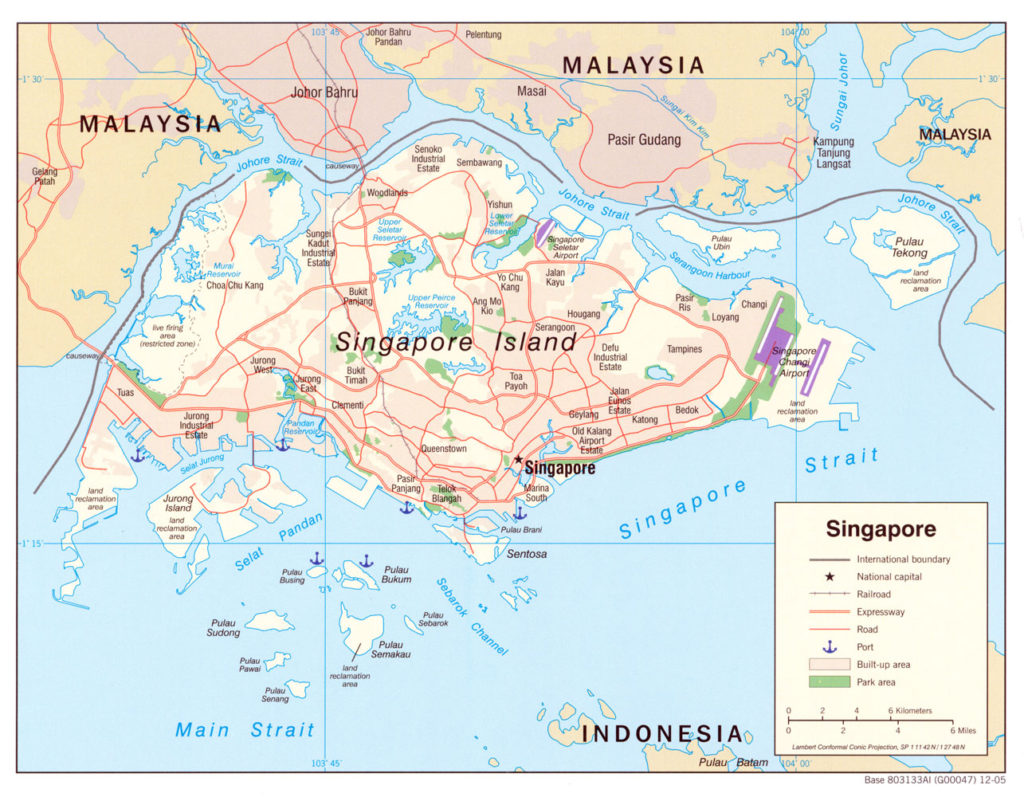
I am met at Changi airport by a mighty waterfall. Known as the Jewel Rain Vortex it cascades 40 metres down. Surrounded by luscious foliage and flowers. Airports don’t get much better than this. It was named the best airport in the world in a global ‘Skytrax’ survey in 2023 and 2024. Although this vote was actually based on people’s experience with entering and leaving, such as immigration and security. Anyway, it is a remarkably pleasurable experience. Enhanced by the fact that a friend of mine meets me. A total surprise. I like surprises.
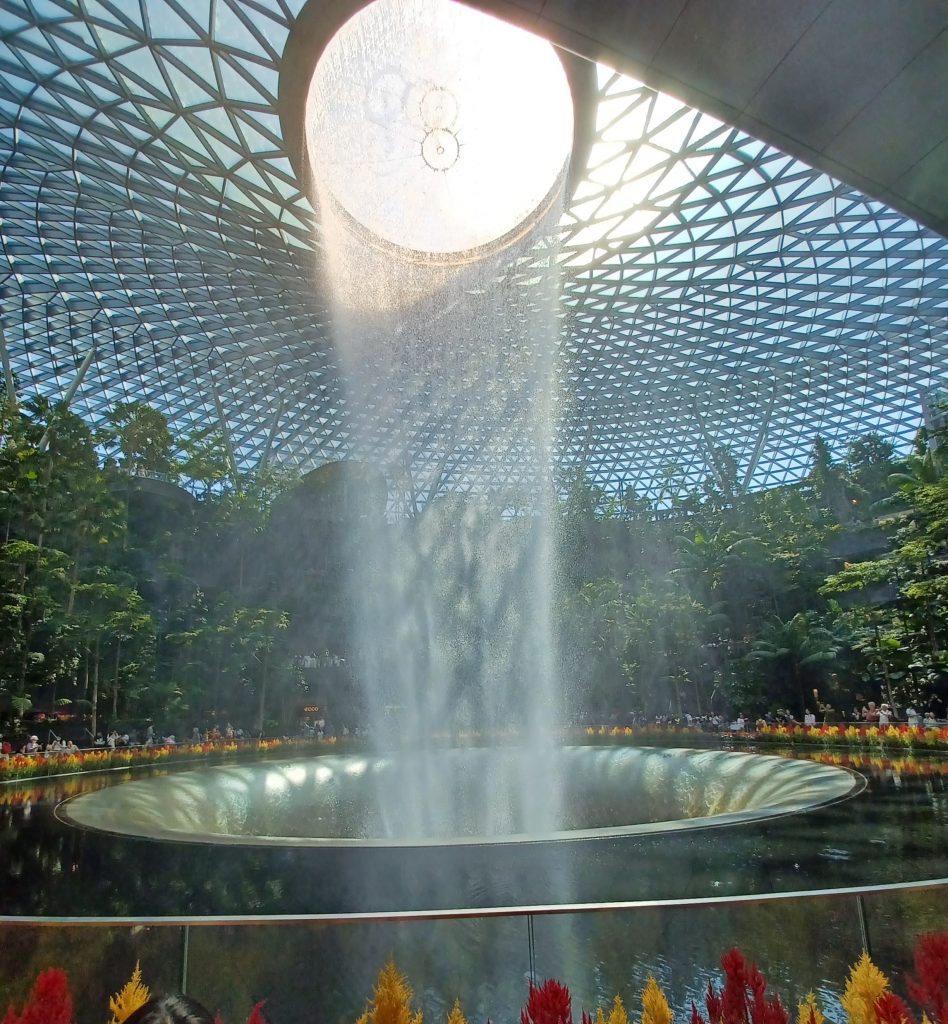
We get a taxi to my hotel near Clarke Quay, my haven of rest for 5 nights.
Clarke Quay and Singapore River Trip
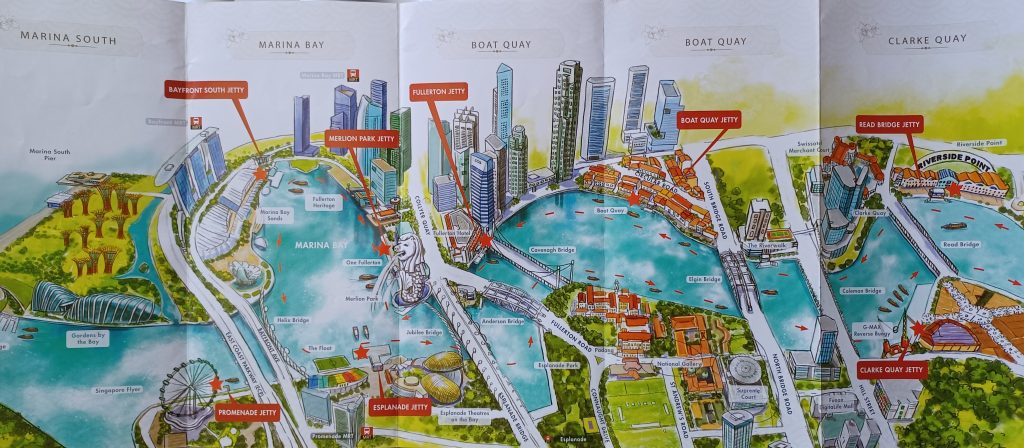
Although a trifle fatigued after the two Emirates flights to get here, I can’t resist a quick recce of Clarke Quay. Thus, having dumped baggage, we walk in that direction. Pastel shades of pink, green and yellow houses, once warehouses, greet us on arrival at the riverside. Cross a bridge to where some tourist boats are moored up. That would be a good introduction to the city wouldn’t it. My friend agrees. She is a local Singaporean and speedily books tickets for the sunset river cruise. After a glass of welcoming Prosecco in a local bar on Clarke Street, currently decorated with Chinese lanterns – as celebrations for the Chinese New Year of the Snake continue – we board the boat.
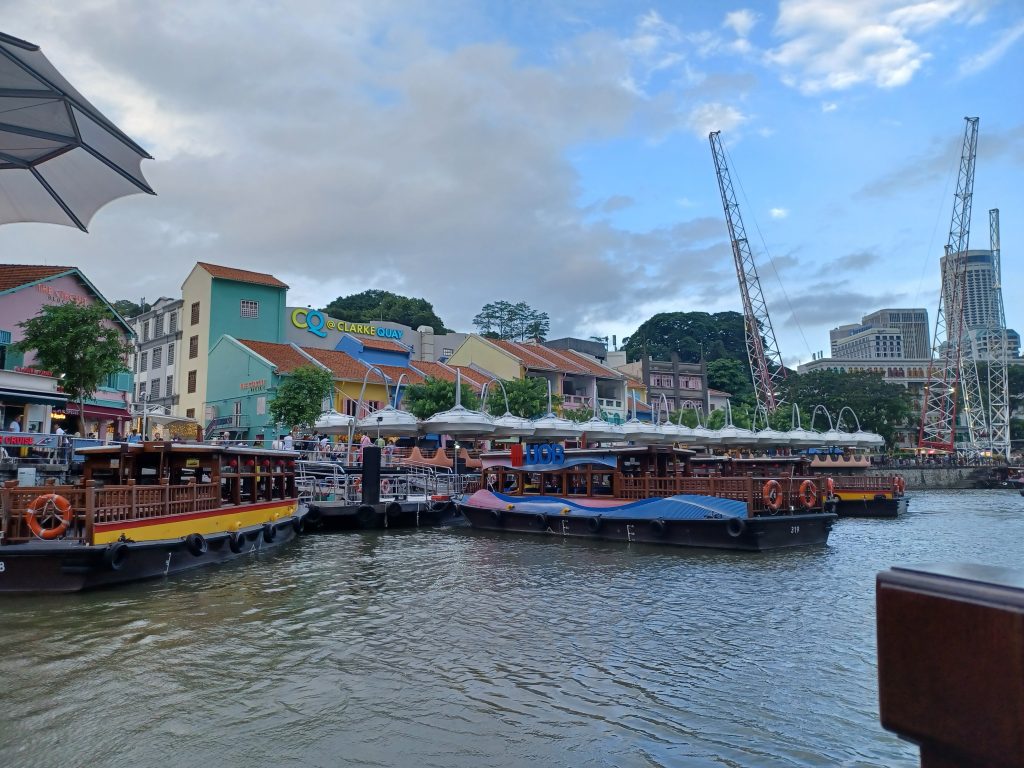
Chug down river, past the G-MAX Reverse Bungy, a sort of catapult. This contraption flings its passengers up and down in some kind of open-air capsule, which also rocks its victims back and forth between two towers. Not for me. Not a chance! Pregnant Mums and those with heart conditions are not permitted to participate.
The boats are rather nice wooden ones known as bumboats, once used to ferry cargo in the port. Most of them seem to be working at full capacity for this end of day trip. Ours is full. I sit on the bow as we motor under the bridges over the Singapore River with British names: Coleman, Elgin, and the lovely cast iron Cavenagh Bridge situated in front of the Fullerton Hotel, once the General Post Office. Seems like a chap is jumping into the river here but, on closer inspection, it is a sculpture of five bronze figures messing about by and in the river in days of old. ‘First Generation’ by Chong Fah Cheong. These young lads, along with the bumboats, hawkers and other ‘riff raff’ would all have been removed, we are told, after the river was cleaned up during the Clean River Project, which was completed in 1983.
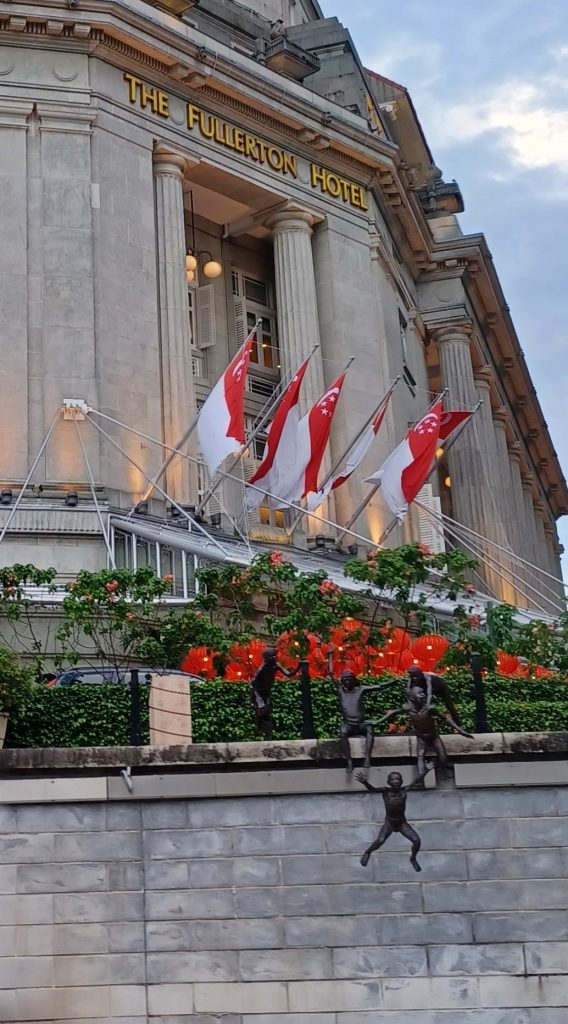
Most of the modern hinterland here is formed of huge high rise blocks, one of which, my friend tells me, she worked in for thirty years. Now we pass below the Anderson Bridge, past Collyer Quay and under the 261 metre long Esplanade Bridge next to where the Merlion spouts into Marina Bay.
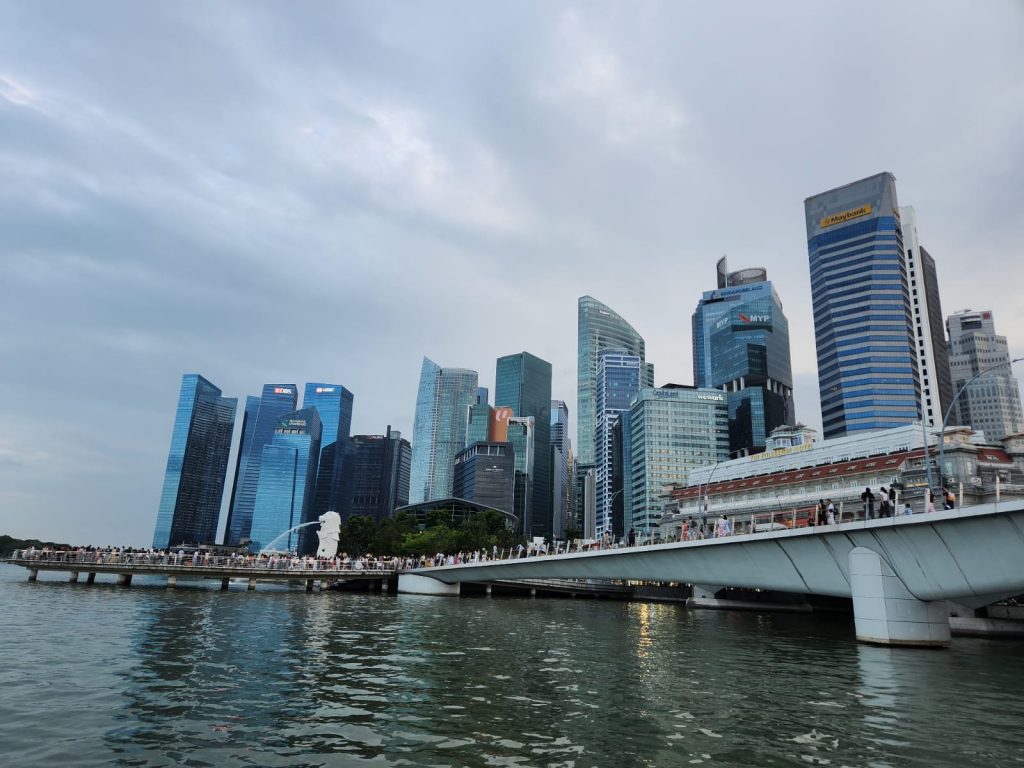
It is in this bay where the huge Marina Bay Sands Hotel, which opened in 2010, ‘floats above the Singapore skyline,’ according to its website. Atop the three accommodation block towers is an observation deck, SkyPark and infinity pool 191 metres above ground. I make a mental note to visit. In front of the hotel is a spherical glass building, built out on the water on a platform, apparently belonging to Apple. And another structure, which looks like a lotus, the ArtScience Museum. Beyond this in the distance is the Singapore Flyer, a huge Big Wheel, the second tallest in the world, surpassed only by that of Las Vegas in the USA. Singapore seems to be a city of superlatives.
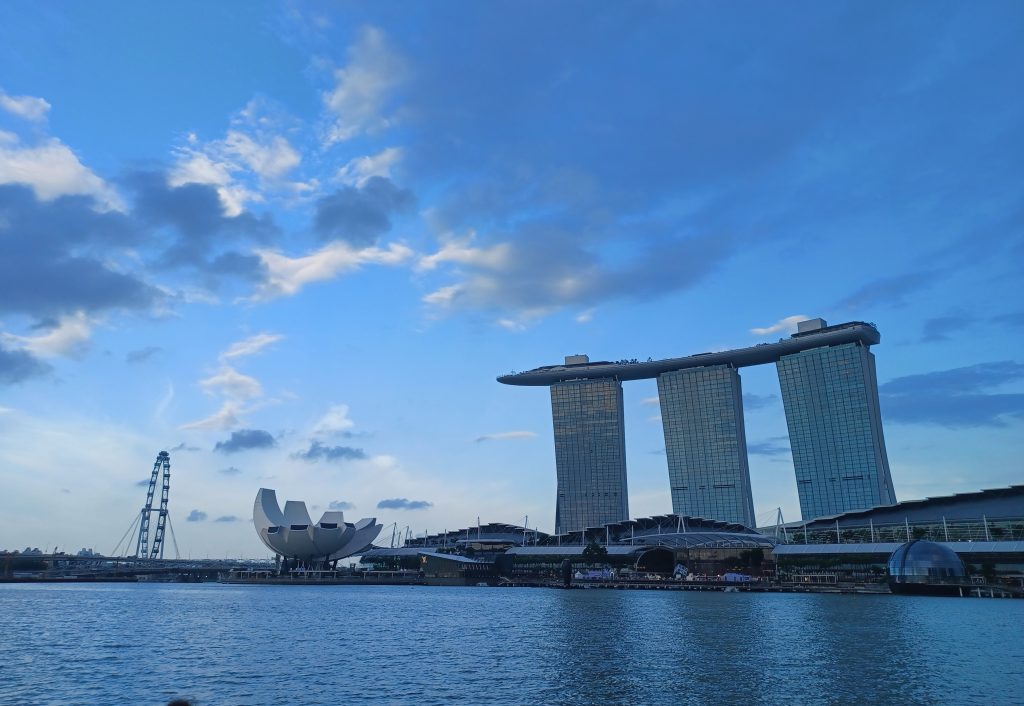
The boat heads back to its mooring and we disembark to sample some Chinese food in a local restaurant for supper. Thus sated, we saunter off.
Around and about are fruit and vegetable stalls, one of which displays plastic boxes full of durian, a large pale green spiky fruit, for sale. Despite being a very healthy fruit, full of necessary iron, vitamins and potassium, its main claim to fame is its aroma. “It smells so bad it is forbidden to take it in taxis,” my friend tells me.
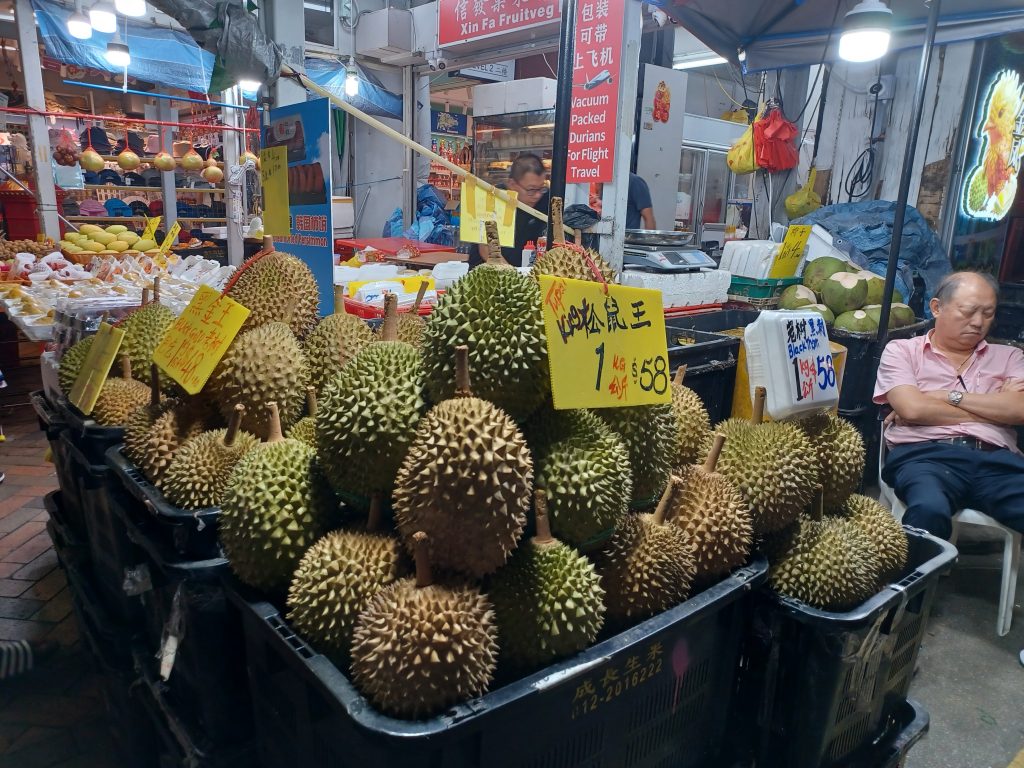
“And on all public transport”. Should we wish to purchase some to take home, however, the merchants offer to vacuum pack said fruit ‘for flight travel’. Now there’s an incentive. The shop keeper seems to have nodded off next to the coconuts. Another time then ‒ perhaps.
The G-MAX bungy is still operating as we make our way back to the hotel. Its passengers are evidently enjoying themselves, shrieking into the darkness. And an Indian temple wishes its visitors a ‘A Happy and Prosperous Lunar New Year’.
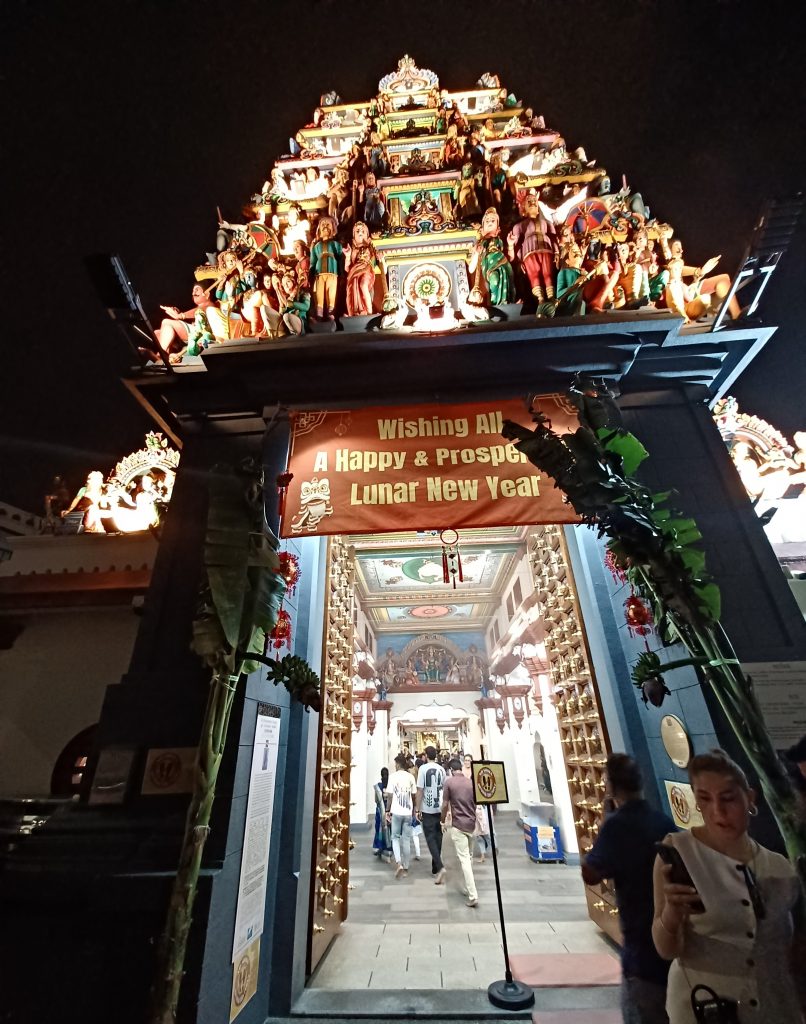
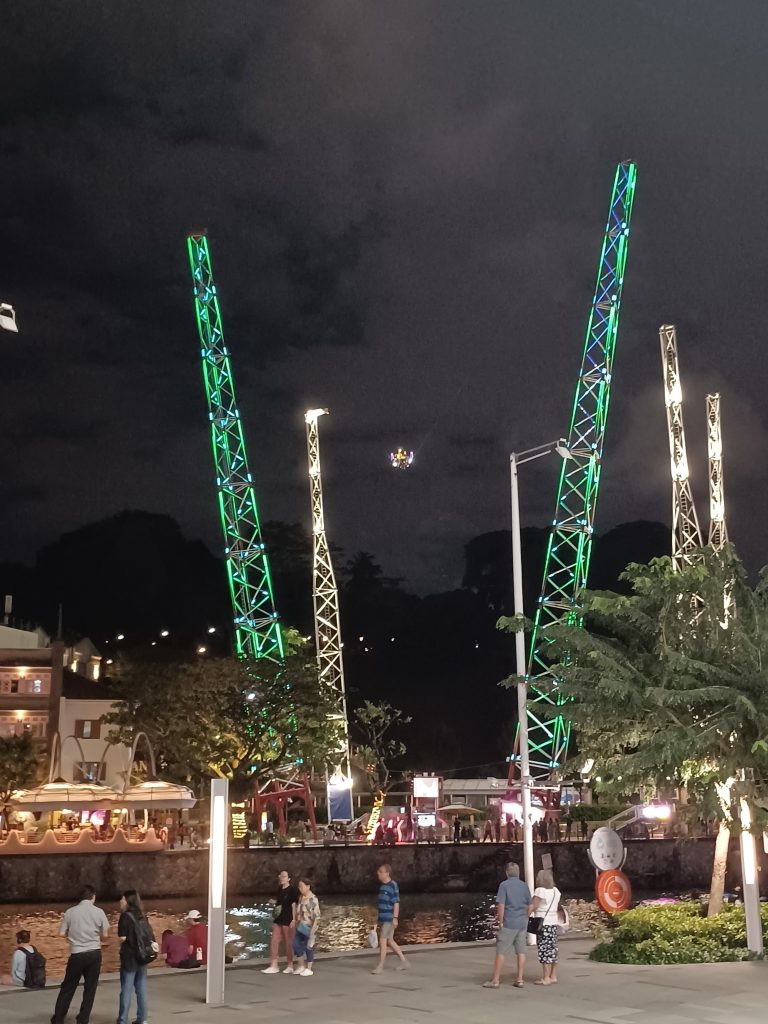
Fort Canning Park
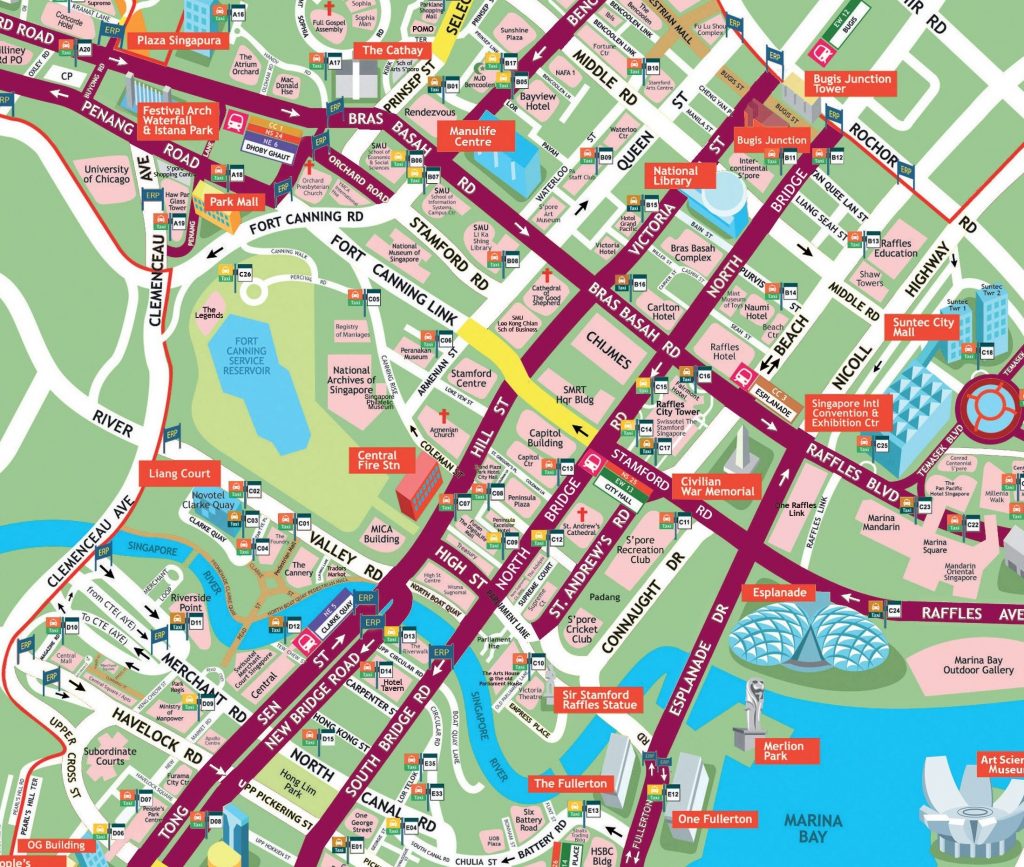
Next morning sees me heading back towards Clarke Quay past another bridge named after a Brit, Colonel Sir Harry St. George Ord, first governor of the Straits Settlements appointed by the Colonial Office, 1867-71. From Ord Bridge I wander to ‘The Foothills’ of Fort Canning Park, named after the first Viceroy of India, Lord Charles Canning. This hill was once the ancient seat of power of the Malay kingdom of Singapura and, later, where Sir Stamford Raffles, founder of Singapore, built his official residence in 1819. Raffles was a very keen botanist, and started a spice garden on the hill. A flower was named after him called the ‘Rafflesia’ and later a botanic garden established on, what was by then known as, Government Hill in 1822.
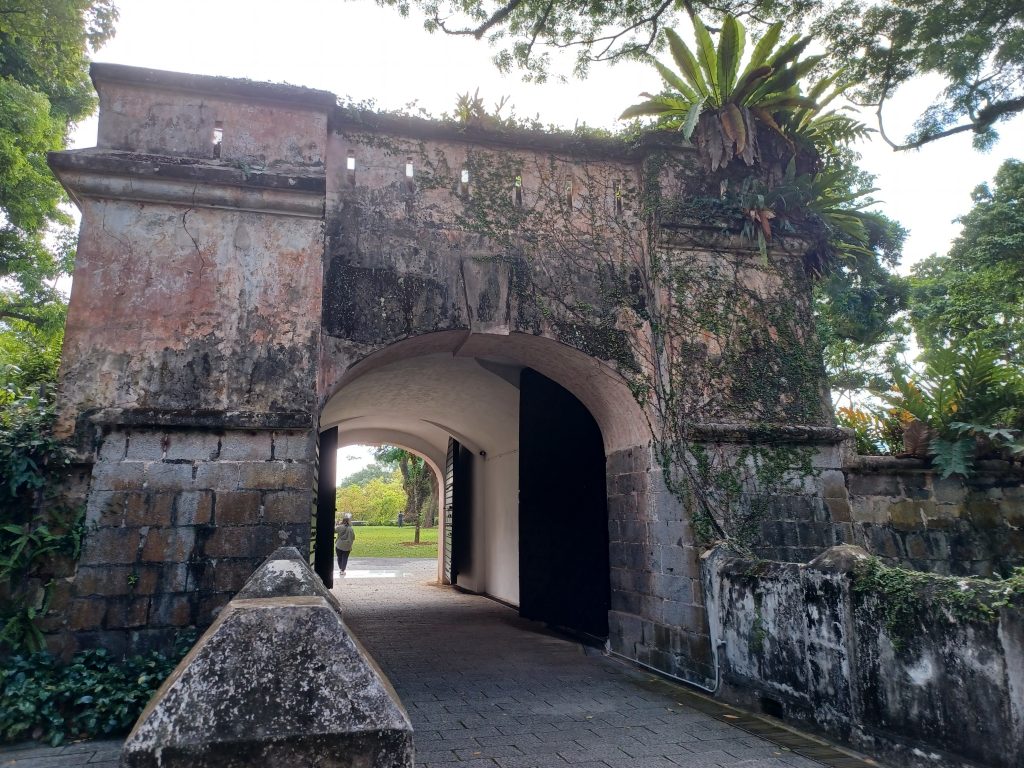
The fort was built in 1860. I walk uphill to its gate and through it. The fort was supposed to protect Singapore from attacks by sea but it turned out to be ineffective as it was too close to the town. In the Fort Canning Centre, once an Army barracks, I read a copy of an extract from the Straits Times of 16 March 1861:
‘It is said that Her Majesty’s government intend fortifying Singapore, and making it the Gibraltar of the ‘Far East.’’ It carries on to say that they hope the fortifications will be different from Fort Canning which has been condemned as ‘utterly useless’…‘by every military man of note.’ The main fort on the highest point on the hill was replaced by the Fort Canning Service reservoir in 1929. Fenced off today.
Many other interesting sights are to be seen on the hill including a bomb-proof bunker, known as the ‘Battlebox’. This was built in the 1930s in the event of a war with Japan and housed the headquarters of Malaya Command. I explore the rooms and tunnels of the Battlebox and view the lifelike models of Lieutenant – General Arthur Percival and his commanders planning their strategy. It was here where the decision was made to surrender Singapore to the Japanese, which took place on 15th February, 1942.
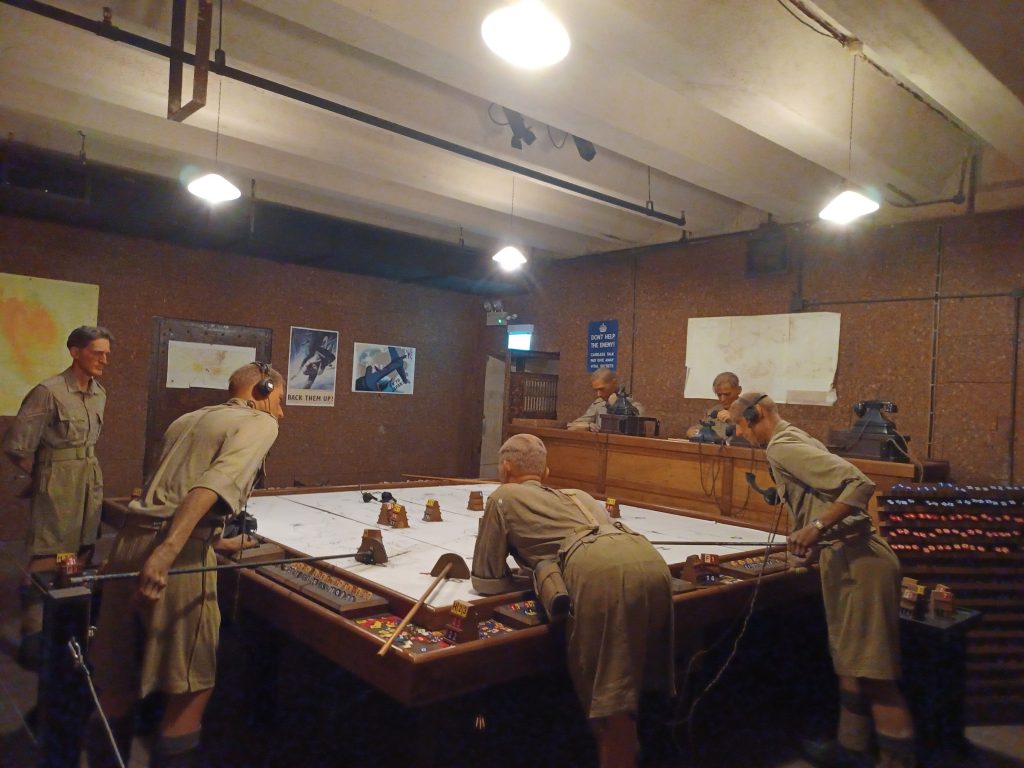
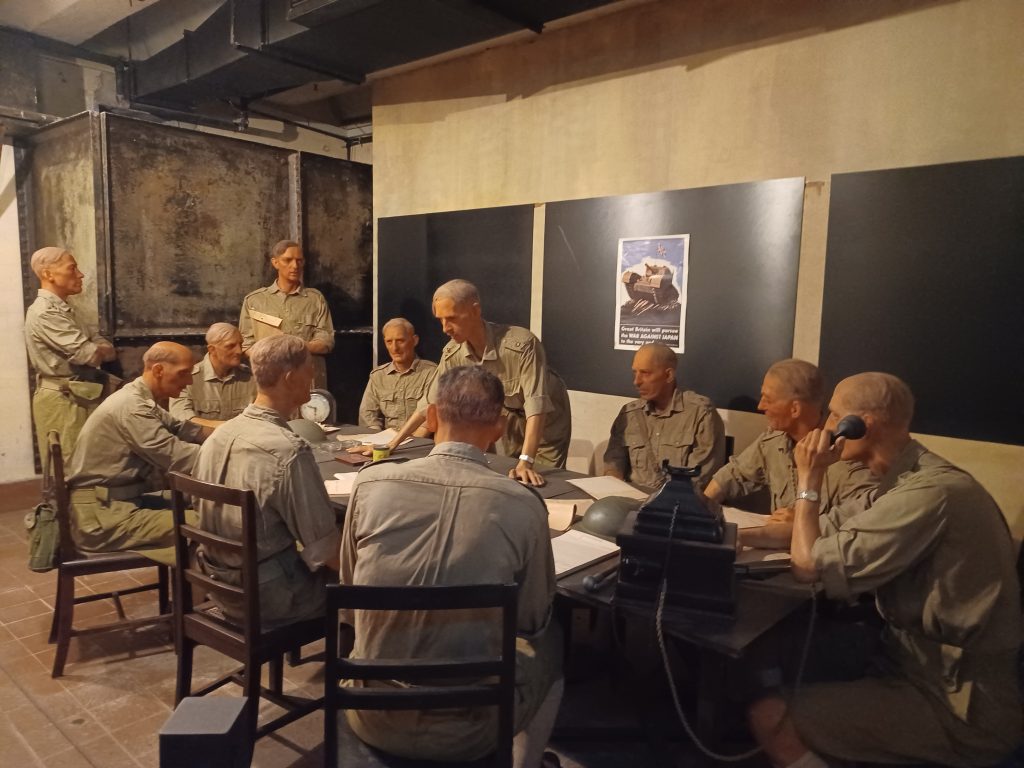
I wander down the grassy slope from the splendid Fort Canning Centre building. People are enjoying themselves strolling or lolling about on the grass in front of it in the sunshine. I prefer the shade, thus walk to a pathway on the boundary where, built into the wall, are some gravestones in shady spots behind the trees. These are, apparently, the few remaining that could be preserved from the former Christian cemetery once on this spot. Tranquil. A place to pause a while. I do. I admire the Fort Canning Centre from here. It is a bit of a gem this old white colonial building with its two wings and open corridors in front. Airy spaces for the residents to stroll along protected from the heat. I drift slowly downwards and exit the park via a Gothic gateway.
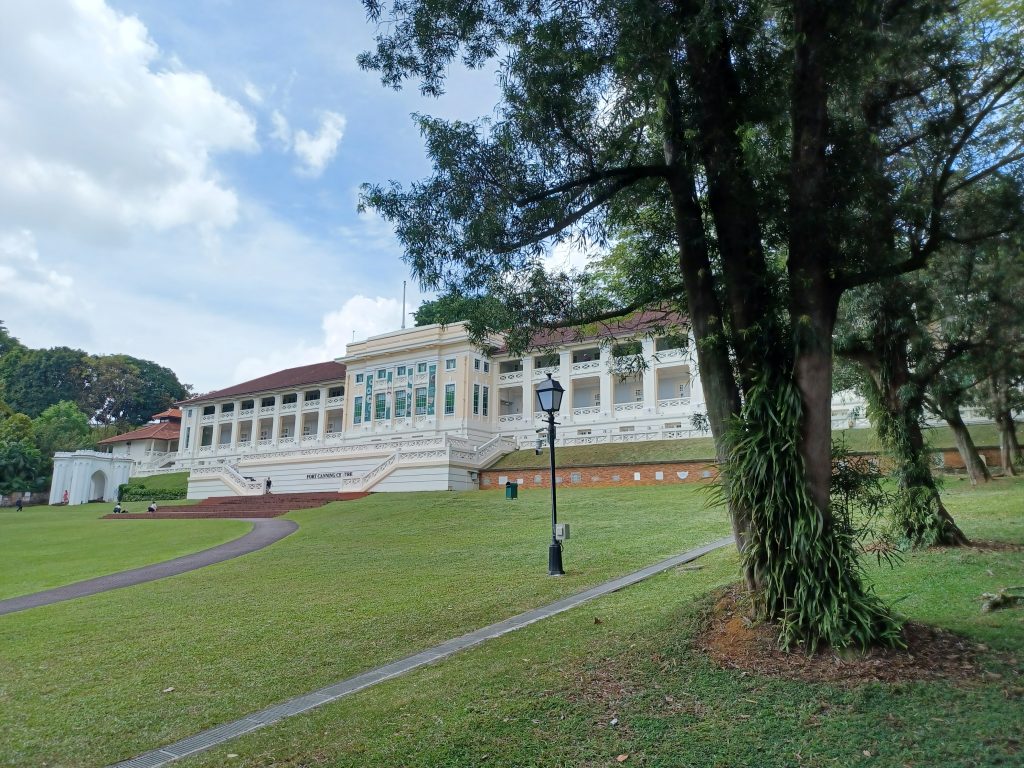
National Museum of Singapore
Below the Fort Canning Centre is the Singapore Museum, which provides further information about Sir Stamford Raffles after whom, apart from the flower, the famous Raffles Hotel is named. There is some interesting information about the Chettiyars in the museum too. I came across their ancestral home in Tamil Nadu, India, when visiting last year (see India, part 2). The Chettiyars conducted trade with the British and also established merchant banks which enabled loans of capital to businesses. As such they greatly assisted in the development of Singapore’s economy.
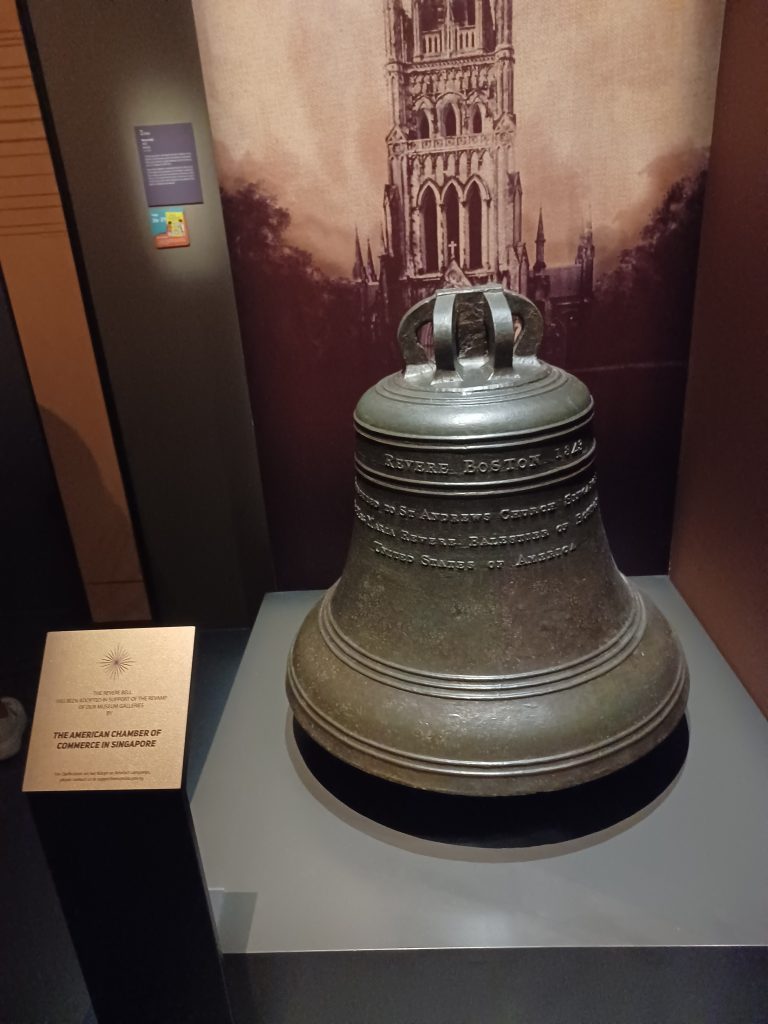
As I amble around the museum the Revere Bell catches my eye. Interesting. This bell was cast at the Revere foundry in Boston (see USA, Part 1: Boston). Revere’s daughter was married to the first American Consul in Singapore and presented this bell in 1843 to the church of St Andrew, now St Andrew’s Cathedral. Her condition was, according to the information given, ‘that it sounded the curfew every night at 8 p.m.’ Supposedly to remind the drunken sailors to return to their vessels. The bell is not useable now. Cracked.
St Andrew’s Cathedral
I now go hunting for St Andrew’s Cathedral. I come across several other churches before realising I am plodding back and forth on the wrong roads. Two Catholic churches turn up first, that of the Good Shepherd and the Church of the Sacred Heart. Also a onetime Catholic convent named ‘the Chijmes’, now hosting a number of bars and cafés in its grounds. Eventually find St Andrew’s Cathedral on Andrew Street. Fairly obviously really. Bright white with modern stained glass windows at the east end. Neo-Gothic style. I enter in. It is rather lovely. Modern Singapore’s high rises overreach it.
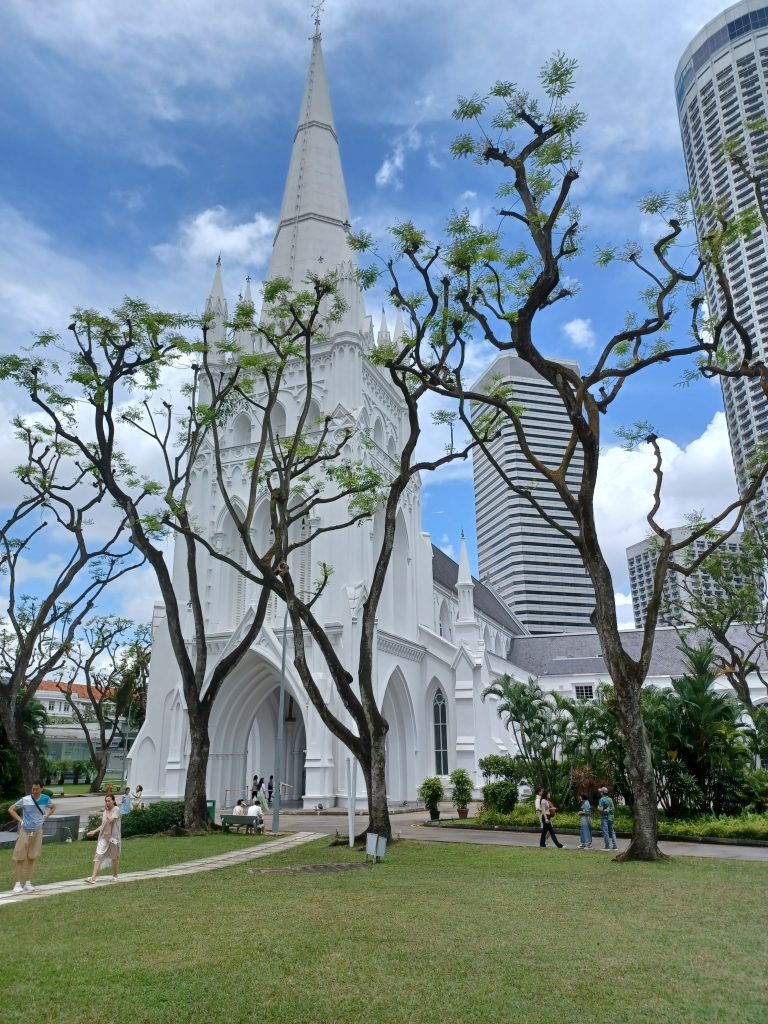
Singapore Botanic Gardens
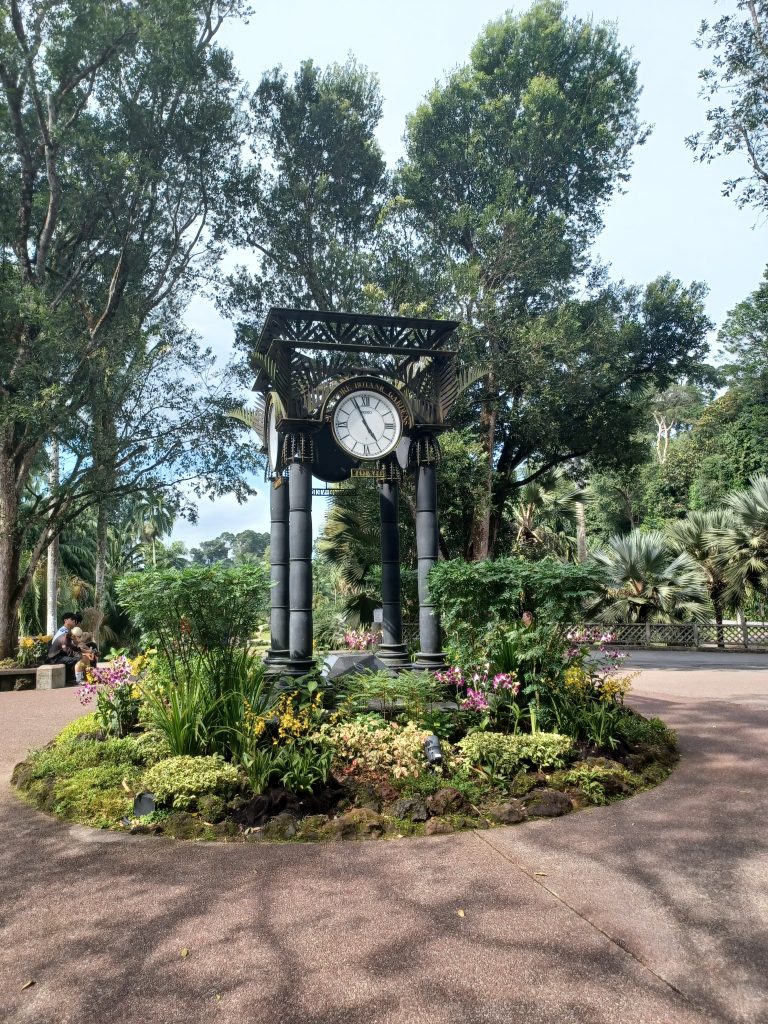
Time now to head west to visit the Botanic gardens, beckoning green and lusciously. Meet up with my friend and hire a cab. A UNESCO heritage site, and the only tropical garden to hold this status, I gather, it was founded in 1859. The first item of interest is the black steel clock with four faces, showing the times for Singapore, London, Vancouver and Tokyo. Rather elegant with the black steel palm leaves around it. Thence to a grassy expanse leading down towards an open air stage, the Shaw Foundation Symphony Stage. This afternoon some sound testing is taking place for a concert this evening.
A chap is sitting under a gazebo on the grass with various bits of equipment ensuring the quality of the sound whilst instrumentalists and singers of The Straits Ensemble rehearse. We make use of the gazebo to sit in the shade and watch the proceedings. Stunning site. The covered stage is surrounded by the waters of Symphony Lake upon which float giant lily leaves.
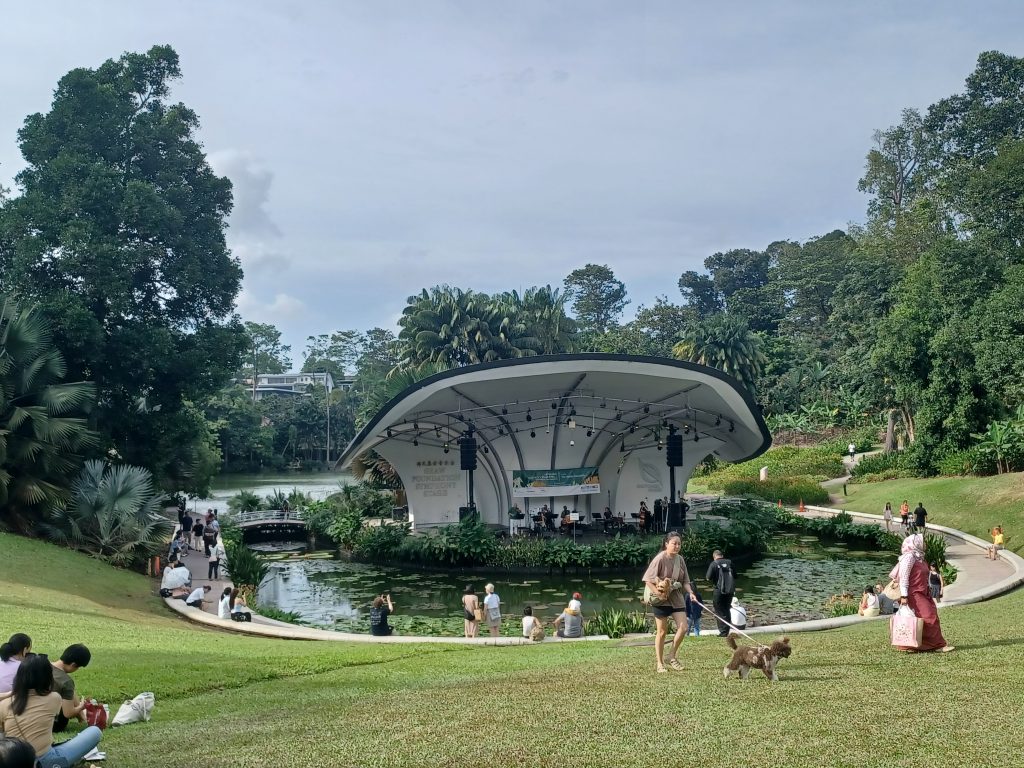
Around the edge and squatting on the grass are picnickers, babies, dogs, locals and interested folks from far and wide. Fabulous gardens. Waterfalls, flowers, ferns, trees and over a thousand species of orchid. Sculptures too and we admire one of Chopin near Symphony Lake. Could spend hours here but I am invited for a Chinese New Year celebration.
Chinese Lunar New Year
We take the super efficient metro or MRT (Mass Rapid Transit) as it is called, and visit my friend’s relatives to celebrate Chinese New Year. A game of Mahjong is in full swing when we arrive. Am soon invited to participate with the family in tossing the Lunar New Year Salad in a bowl using chopsticks. My friend’s brother-in-law adds various ingredients to the mix, each representing an auspicious wish, followed by condiments, serving the same purpose. All rather jolly. Eat the salad with chopsticks. Not had much practice with these lately. The salad was the appetiser and is now followed by further dishes including pigs’ trotters. Not equal to that particular challenge, but other meats and fish are available to stab at. Ritual over, meal consumed, the family settles down to Mahjong again, clattering the little tiles with which the game is played, all over the table, and we take our leave for the bright lights.
Long Bar, Raffles Hotel
It is time to venture now, as have many before us, to the Long Bar in the famous Raffles Hotel, which was built in 1887. Rudyard Kipling, Somerset Maugham and Ernest Hemingway, among others, frequented the Long Bar in colonial days. I am not the first foreigner that my Singaporean friend has happily accompanied to the Long Bar, all being desirous of indulging in Singapore Slings, the equally famous cocktail. Most of the clientele queuing at the door here are foreign tourists.
Don’t have to queue too long and are soon welcomed within by a tall waiter with courteous demeanour, and swept to a table on which perches a hessian bag of peanuts with ‘Long Bar’ stamped on it. A tradition it is, I understand, to toss the shells of the nuts onto the floor. Stems from the fact that some early clientele were planters and swept the shells of the peanuts offered to them off the bar, according to the Raffles website. Must be the only place in Singapore where ‘rubbish’ is permitted to be strewn. The rather nice tiled floor is smothered with them. We place our order and dutifully shell nuts whilst peering round at the dark wood decor and old pictures.
The Slings are shortly conveyed to the table on a tray. Long glasses of orangey elixir with straws. It was first mixed in 1915, I gather, by a bartender named Ngiam Tong Boon, who disguised the gin-based drink to look like fruit juice so that women could drink it, it being beyond the bounds of respectability for females to indulge (publicly at least) in alcohol at that time.
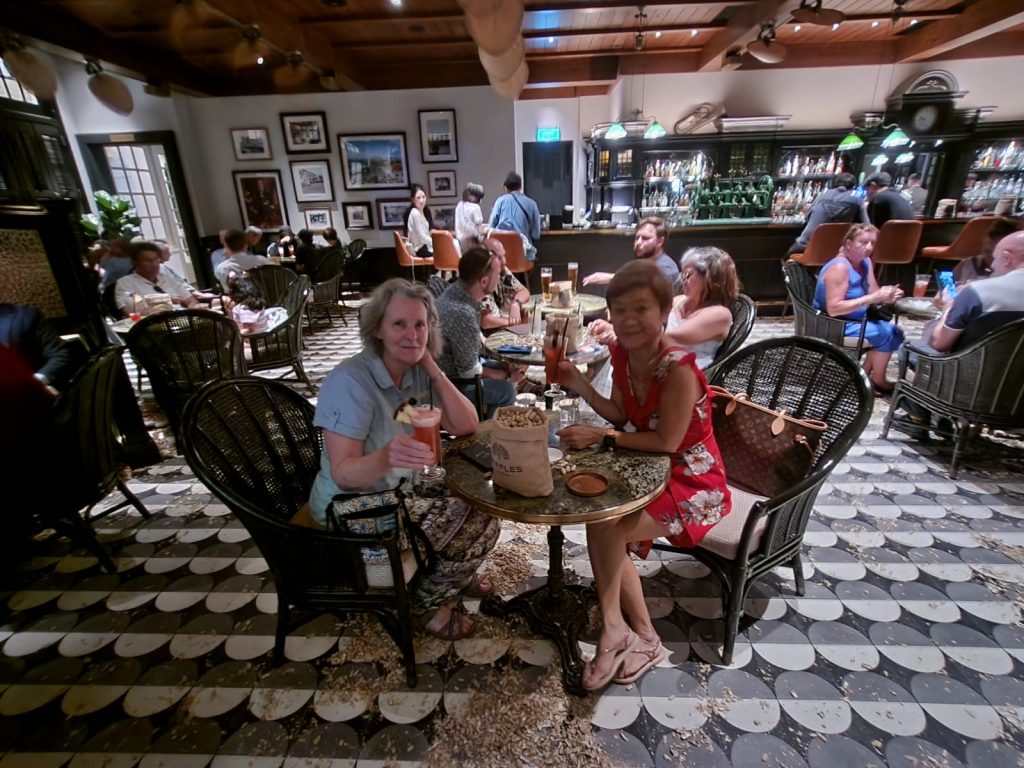
No issues now. We indulge in not just one, but two glasses of the flavoursome nectar, slinging nut shells with abandon. The hotel makes a considerable profit from the sales of this cocktail, which costs 37 Singapore dollars a throw. ‘’We sell at least a thousand every day’, the waiter tells us cheerfully.
In benevolent mood, we totter around the glittering streets nearby passing the Blu Jaz café, some stunning murals and the lovely Masjid Sultan mosque. Not at all sure where we are personally. Perhaps after those two Slings, it is not surprising. Pleasant it is to roam around the lively streets at night though. Thence to my hotel. I have earned a night’s repose.
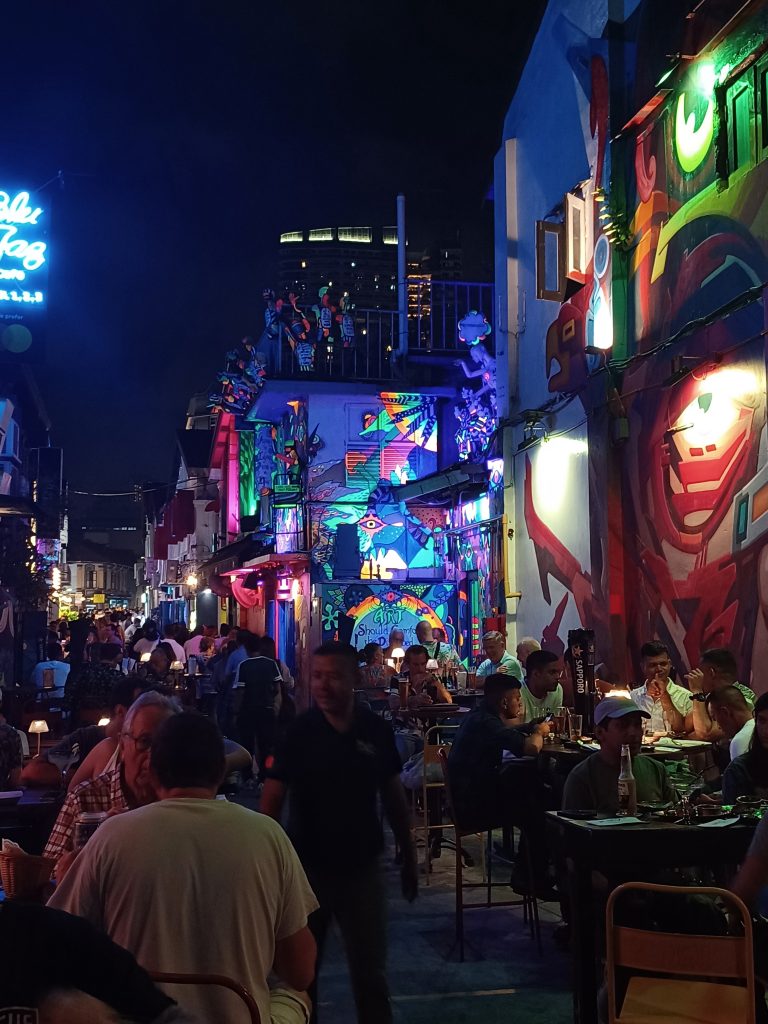
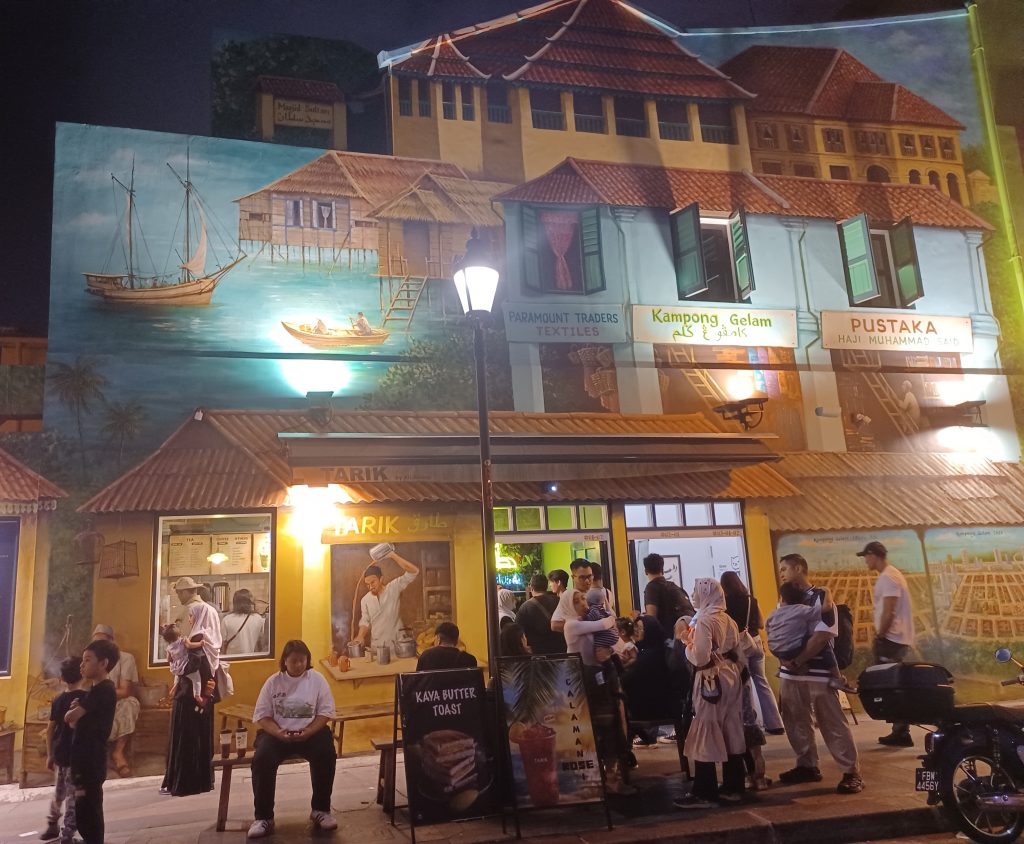
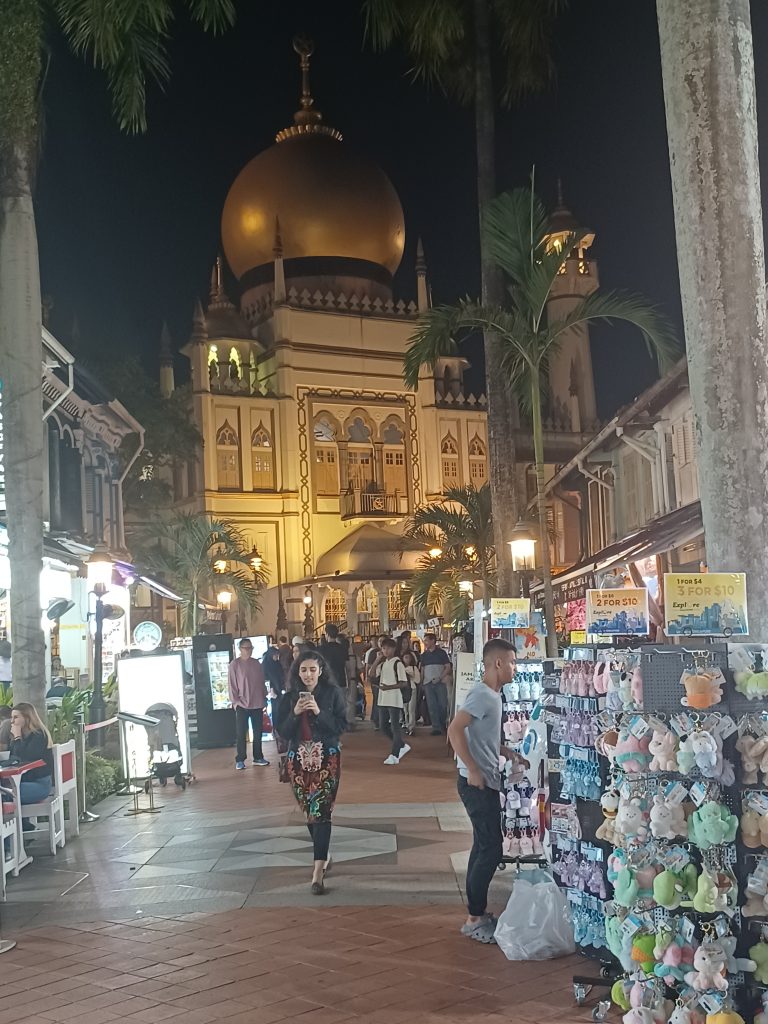
Worship
Bit lethargic today after pounding the pavements of Singapore yesterday. A visit to the Kranji War Cemetery is on the agenda. But first I visit some temples with my friend’s relatives, who are coming to pray at the Kwan Im Thong Hood Cho Buddhist temple. Kwan Im is the Goddess of Mercy, I am told. Some worshippers stick joss sticks in an urn outside and give donations, while others enter in. All a bit crowded with people jostling for space. I observe from afar. Next door to the Chinese temple is an Indian Hindu temple, the Sri Krishnan Temple. They go in there and pray there too. Can’t work that out. My friend says they worship all the gods, that it is a tradition. Hindus also worship at the Chinese temple. OK. Known as ‘cross-worshipping,’ apparently.
Thence to a local eatery. Self-service outdoor place, whereby you bring your own cleansing wipes and clear off the previous customers’ mess. They grab a plastic table with its small stools and I squat down with hundreds of others while they go off to various booths to purchase lunch. Not hungry personally. Recently breakfasted. Friend returns with plastic bowls full of some kind of seafood and bowls of soup, along with separate plastic lid size containers with chili and other condiments to spice it up a bit, so I am told. I sip a cup of flinchworthy black tea whilst they cheerfully scoff it all down.
Their apartments are up north, closer to the Kranji War Cemetery than we are here.
We get a lift to their apartment complex, which is full of shops and eateries. And, unexpectedly, an outside covered area, from the roof of which are suspended about sixty bird cages. Space for 100. Each contains an Oriental White Eye, a small greenish yellow bird with a white circle surrounding the eye. Hence the name. Attractive. All sixtyish are tweeting at each other, whilst the owners, mostly men of a certain age, lounge about listening to them. ‘His name is Ahmad’, volunteers one owner. A popular Malay name, which means ‘praiseworthy’. Very fitting.
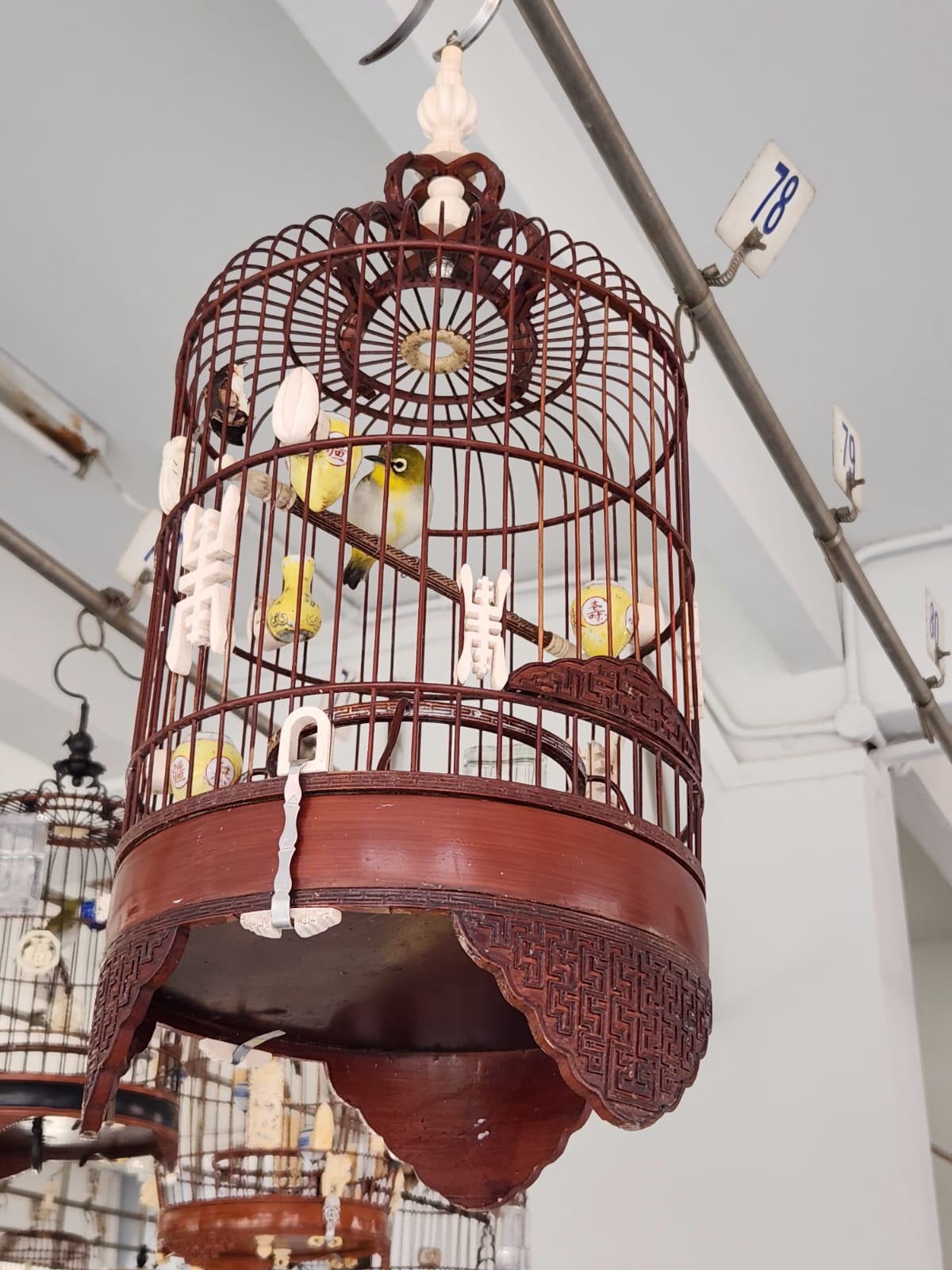
Kranji War Cemetery
Take a taxi to the War Cemetery. It is in the north of Singapore, not far from the Johore Strait, the border between Singapore and Malaysia. Anyway, the driver is supposed to drop us there but cannot find it. We alight in a smartish residential area and meander about in the heat looking for it. I spy a tall monument from the road. Head along the verge up a grassy bank, thence along a path between hedges and slip through a twiggy gap to find ourselves in the grounds. Dust off the undignified leaves and prickles and head to the headstones.
It is all rather moving. The memorial itself was designed to look like a World War II fighter plane from above and on its twelve walls are engraved the names of 24,000 soldiers, who died without a grave. Over 4,400 are actually buried here, some transferred from the Changi POW camp and from other places in Singapore and also from Vietnam. Maintained by the Commonwealth War Graves Commission, each headstone is carefully tended, surrounded by plants and trim turf.
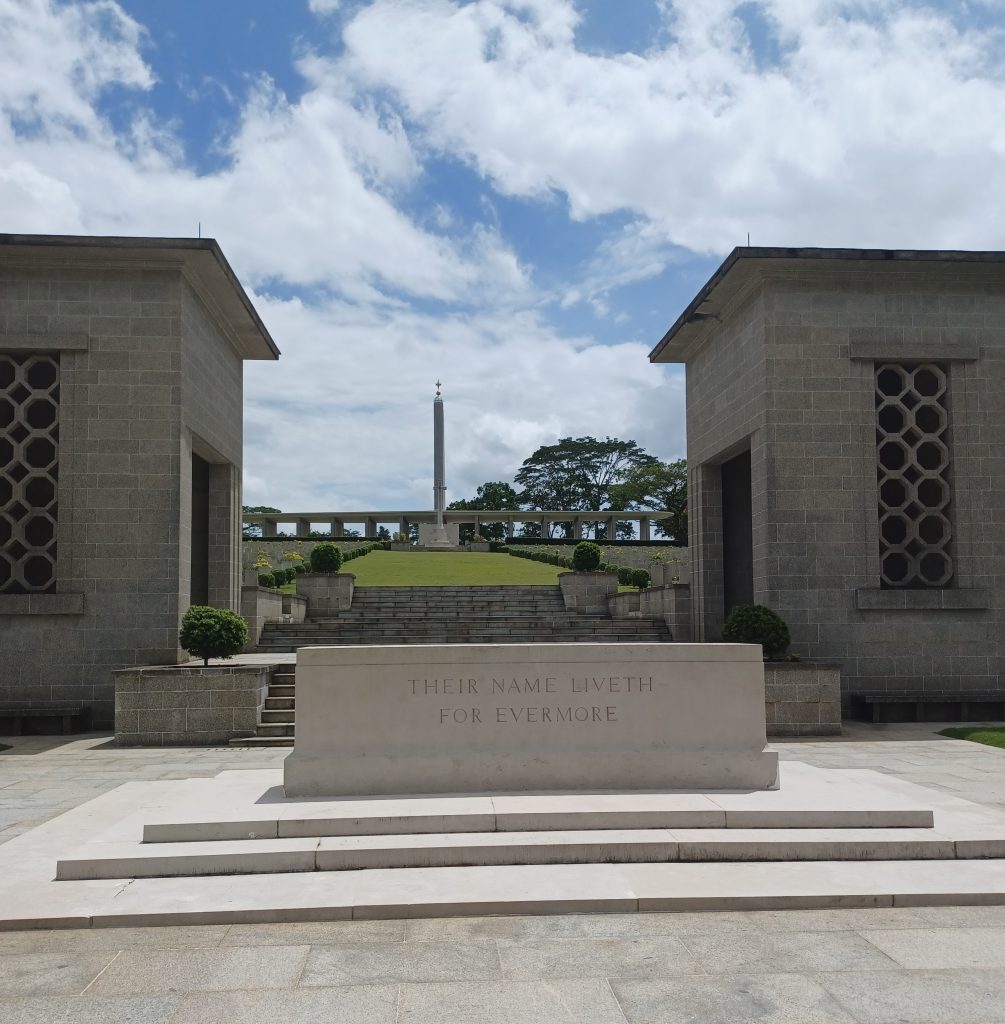
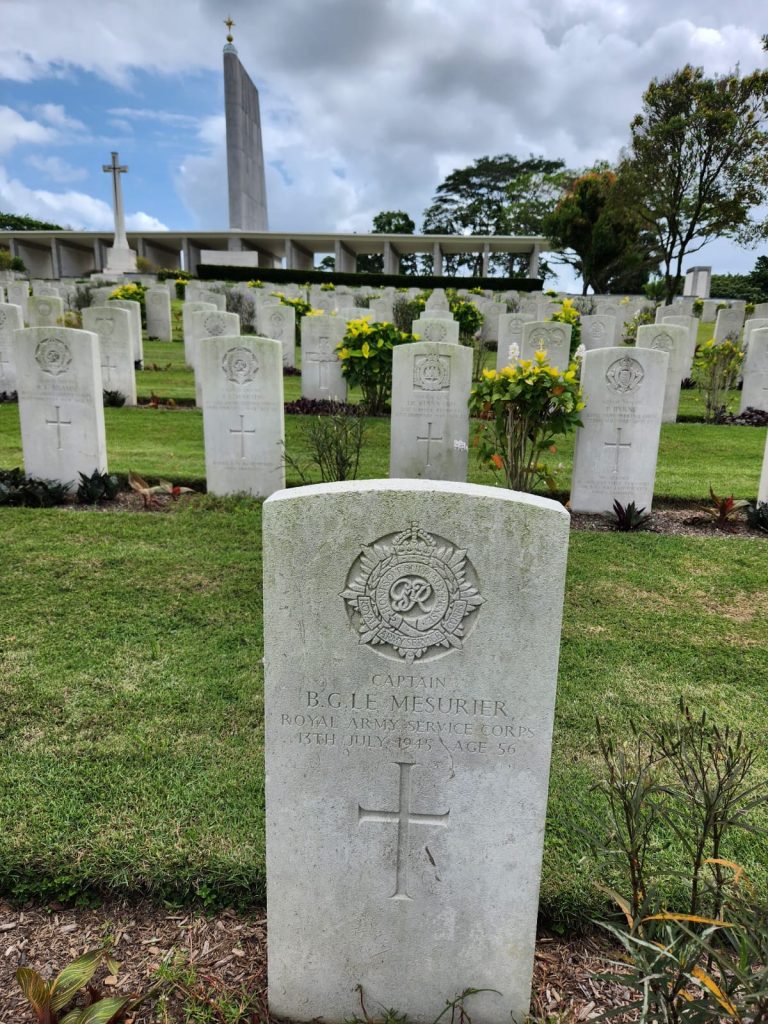
The headstones are arranged in sections: e.g. an area containing burials of those killed in the time leading up to the surrender of Singapore to the Japanese, another with those who were killed during the Japanese occupation from February 15th 1942 until 1945 and another with those who died after the Japanese surrender to the allies. A section is devoted to Indian forces, another for the Gurkha Rifles, the RAF, Royal Artillery, Royal Army Service Corps and many other units. We walk silently up and down the rows.
Clarke Quay
A lazy day ensues after a lazy breakfast in my hotel. Foliage separates the breakfast room from the road and mynah birds are whizzing about inside whistling in accompaniment to my sumptuous breakfast. Lot of fruit to choose from including papaya, water melon, pineapple and dragon fruit, a soft white fleshy fruit with black seeds and red skin. Sink in soft chair and wash it all down with tea.
Thence an amble to Clarke Quay to revisit in the daytime. I head along the south bank of the Singapore River past colourful buildings, boats and bridges. Exit from an underpass to view the rearing high rises above the small shops, cafés and restaurants gradually opening up for the day. Lot of trees planted for shade all the way along and all very clean. One or two smokers stand on the edge of the promenade, the first I have seen. Wonder where they dispose of their cigarette ends as dropping litter is not permitted here.
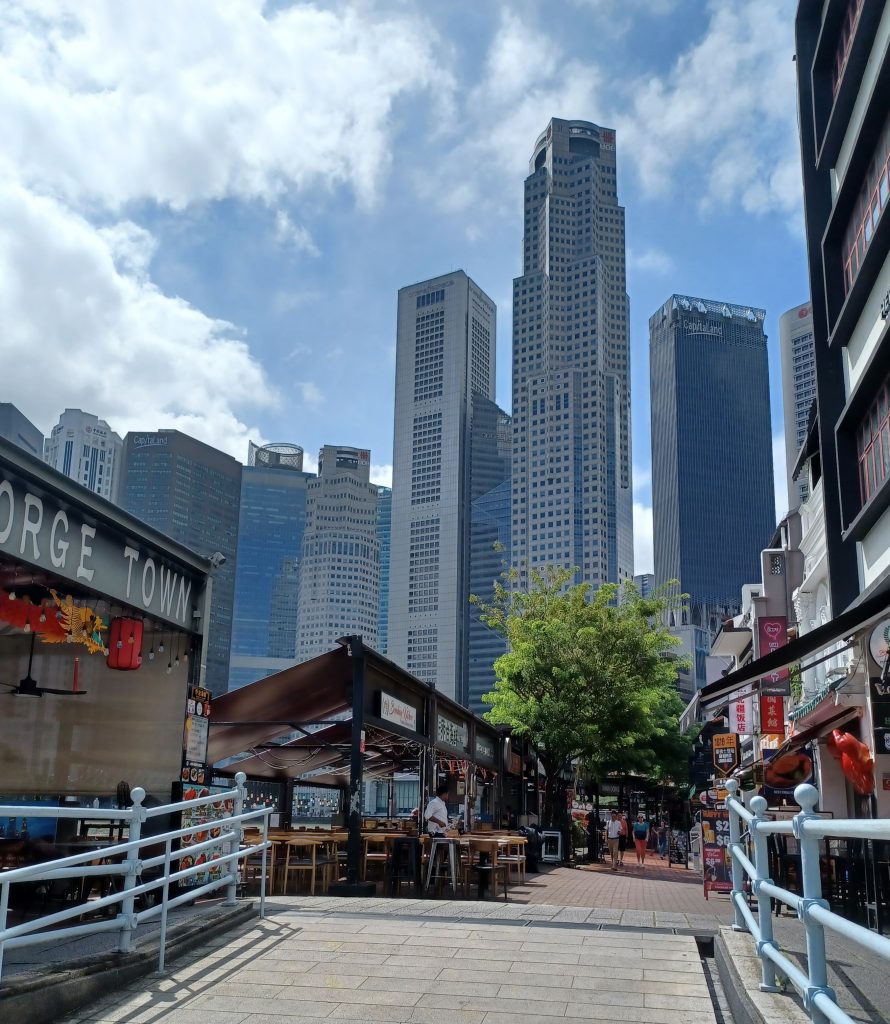
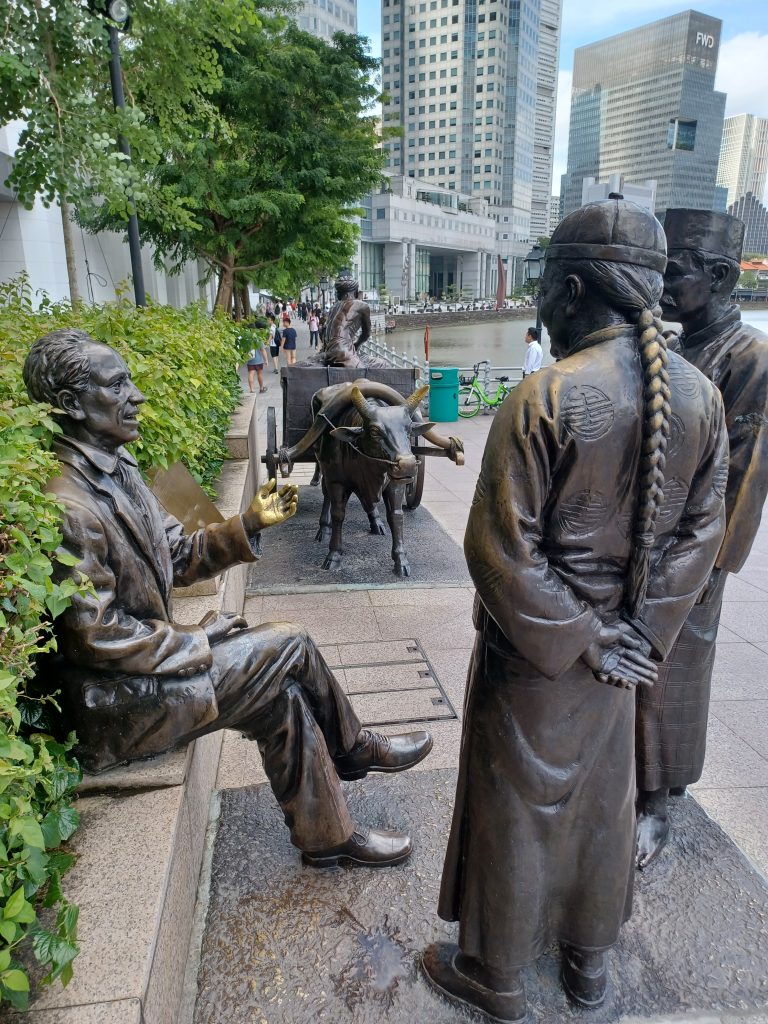
Reach a set of sculptures of ‘The River Merchant’ by Aw Tee Hong just before the Fullerton Hotel. A board informs interested sightseers that it portrays ‘a prominent merchant of early Singapore mediating between a Chinese Trader and a Malay Chief whilst Indian and Chinese coolies load sacks onto a bullock cart’. Supposed to have been a common scene back in the day. The merchant was a Scot named Alexander Laurie Johnston.
The Cavenagh Bridge is a few meters away, underneath which some men are painting or cleaning its underside. Can’t quite tell which. This bridge is described on a plaque as the ‘oldest and only iron cable-stayed bridge in Singapore’ and was ‘named after the last Governor of the Straits Settlement under the government of British India (1859 – 1867’.
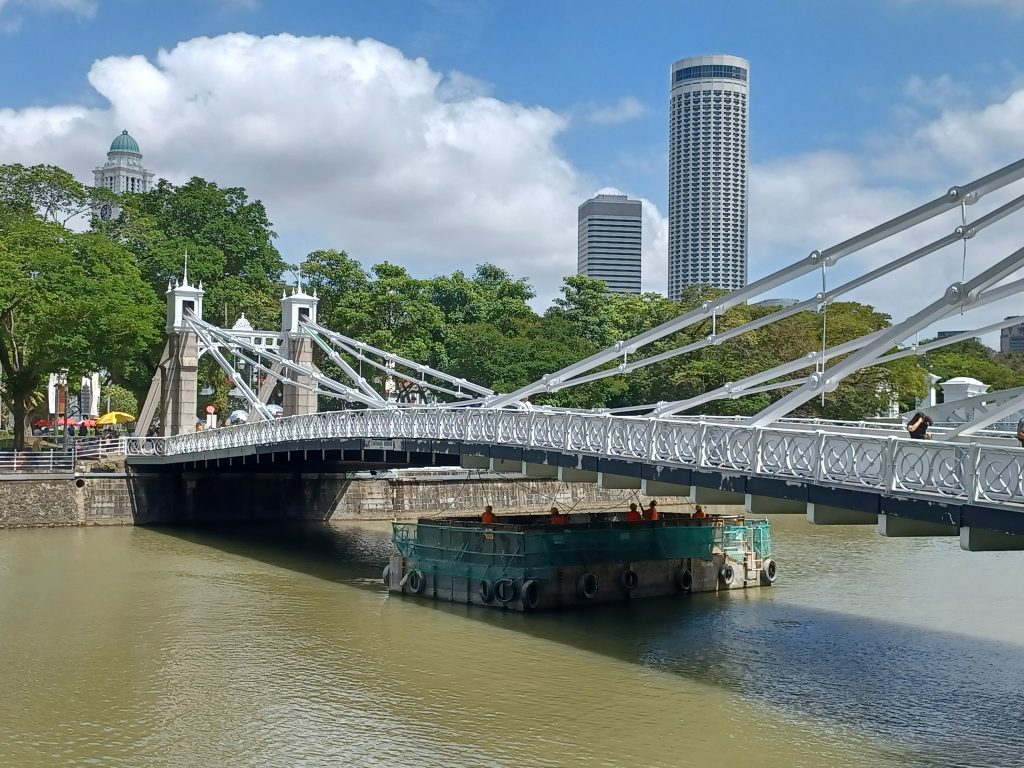
Fullerton Hotel
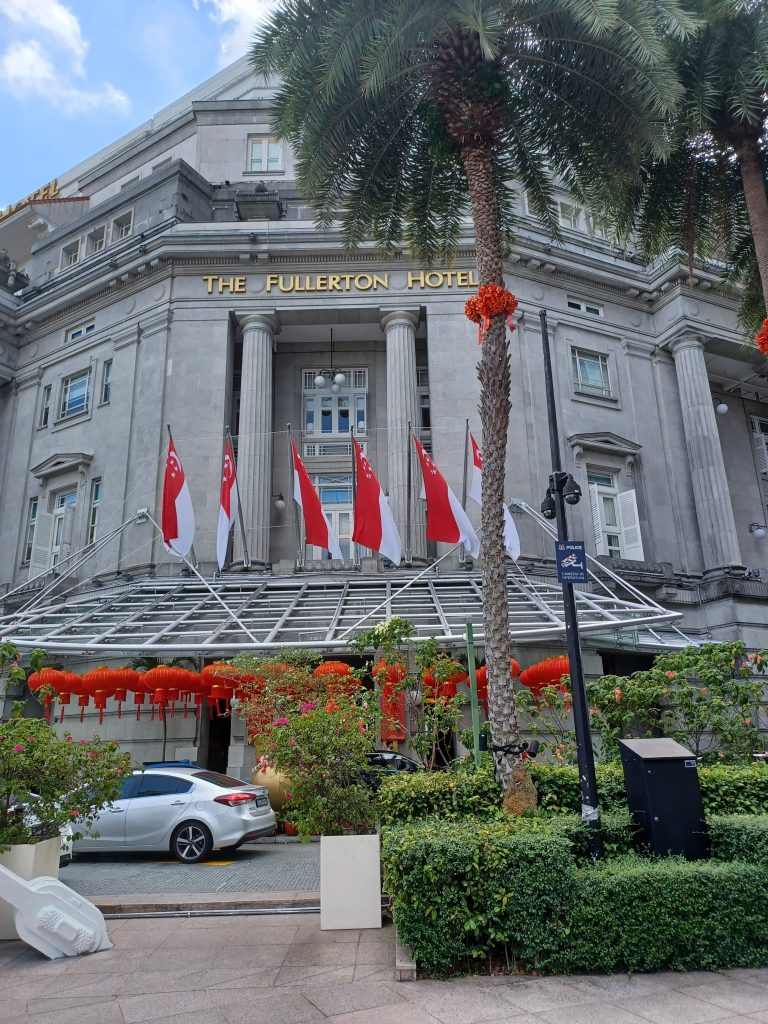
Coffee time. The Fullerton Hotel stands imposingly in front of me with its two Doric columns and six flags of Singapore flying outside. The flag is in two sections of red over white with a crescent moon and five white stars. Very symbolic. According to the National Heritage Board of Singapore website, the red colour stands for universal brotherhood and equality, the white symbolises purity, and the crescent moon ‘a young nation in the ascendant,’ while the five stars represent Singapore’s ideals of democracy, peace, progress, justice and equality. It was adopted officially as the national flag upon Singapore’s independence in 1965.
Enter the Hotel, which is named after the first governor of the Straits settlements (when appointed by the British East India Company), Sir Robert Fullerton, another Scot, from 1826 to 1830. He it was who built Fort Fullerton at the mouth of the Singapore River to defend the harbour. I am greeted by two teddy bears in Chinese dress in the entrance hall. OK. Chinese lanterns all over the place. Make for the café area. Order the Fullerton blend coffee and soak up the atmosphere of the onetime old post office. Very high ceilings keeps the café nice and cool.
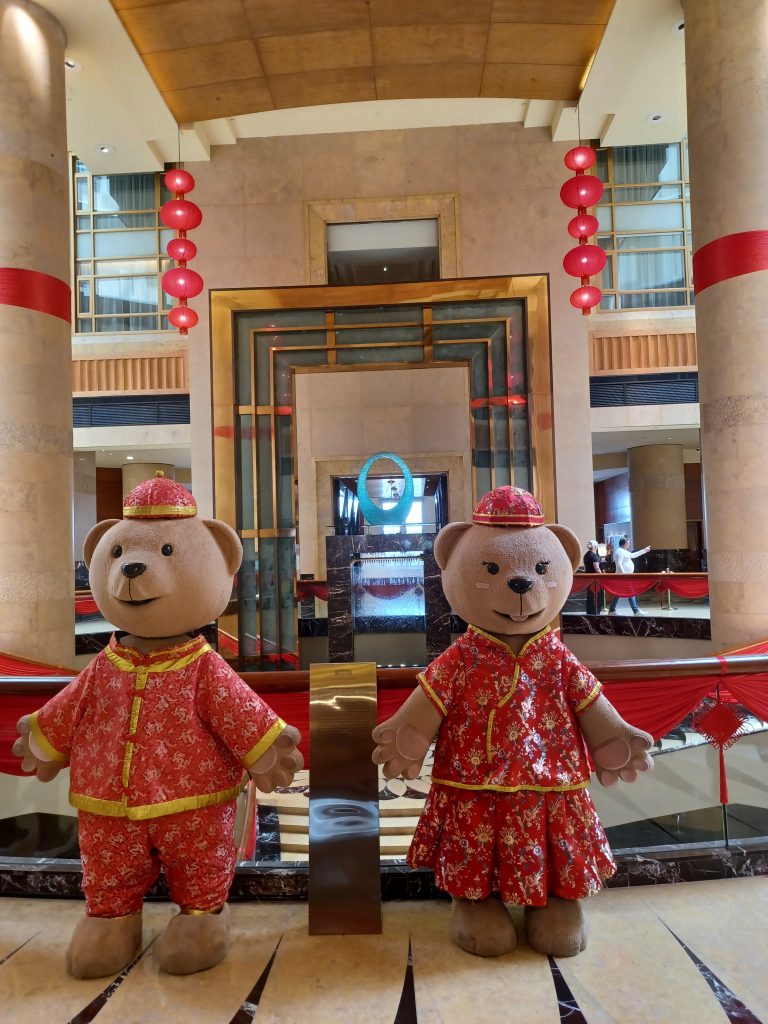
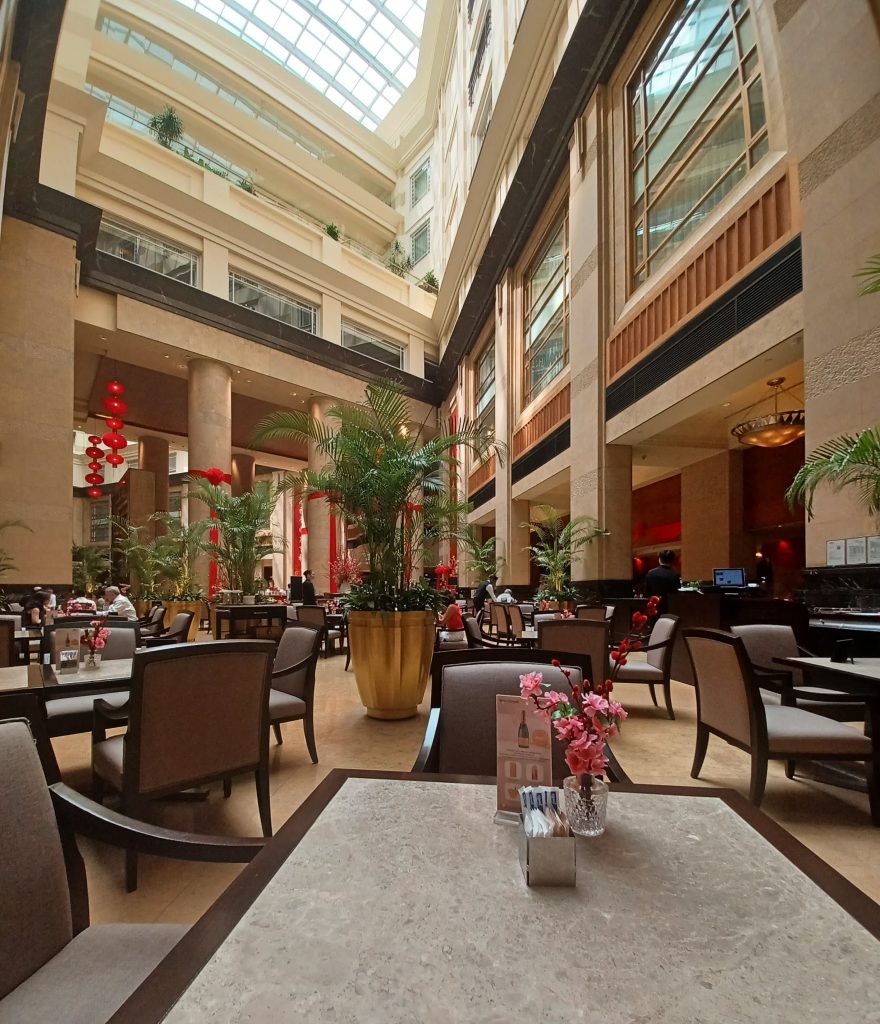
After refreshment, I peruse the Fullerton’s heritage gallery. There is an old red post box here ‘for local and overseas mail’. Some original letters are displayed under glass with their stamps on envelopes along with some airmail letters. Remember those! And some old photographs show the GPO as it once was with its 90 metre long wooden postal counter. Wonder what happened to that. The GPO occupied three floors of the six storey building. At that time, the Singapore River was the centre of trade and the GPO the ‘nerve centre of trade and communications.’
Situated at the centre of Singapore, the GPO was known as ‘mile zero’, ‘from which all addresses take their bearings’. The building later housed the Ministry of Finance and was the gathering place for ex pats and migrants awaiting news of home. It was opened in 1928 by another governor of the Straits Settlements, Sir Hugh Clifford.
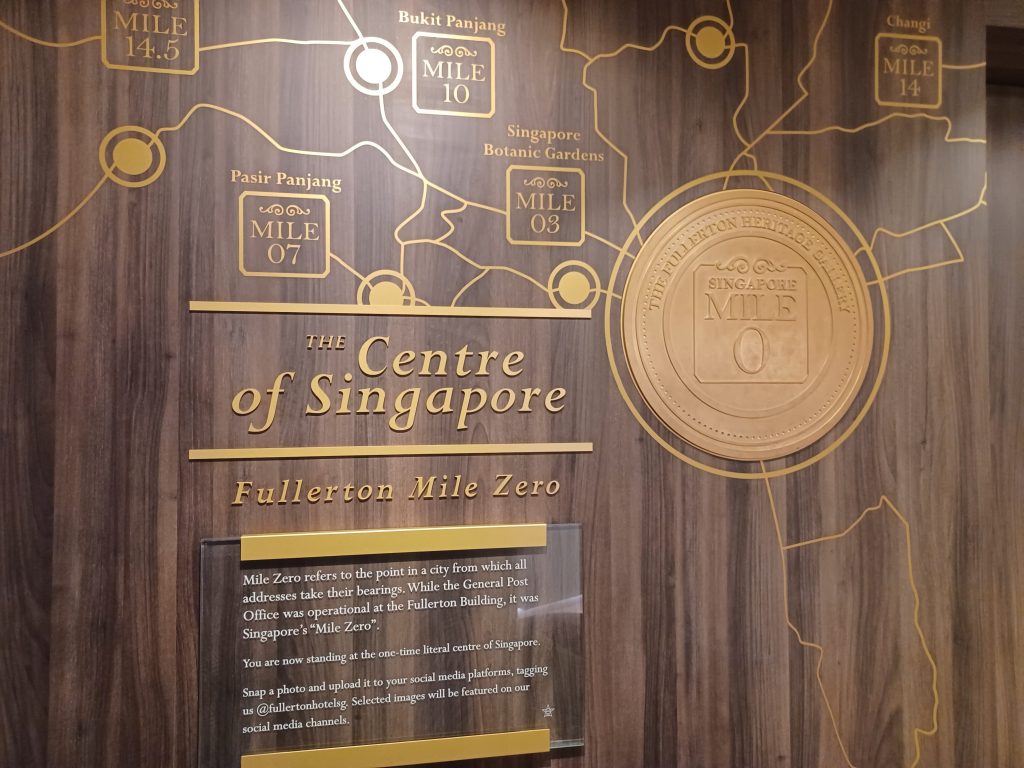
I exit the hotel and cross the Cavenagh Bridge, now gazetted as a national monument. The bridge was erected to link the commercial district on the south bank with the civic district on the north bank, and was much used by local rickshaws and carts and animals. It eventually became unable to bear the quantity of traffic and a Police notice ‒ still in situ ‒ was put on it forbidding its use by traffic over 3 cwt in weight and ‘all cattle and horses’. It is now a pedestrian bridge. Having crossed, I head along the north bank to the, now, cultural district. Here stands a bright white statue of Raffles. Looks somewhat miniscule in comparison with the behemoths round about. Anyway, Raffles landed here on 28 January, 1819 changing Singapore’s destiny ‘from an obscure fishing village to a great sea port and modern metropolis’, according to the plaque underneath. He stands outside the Arts House of the Old Parliament next door to the Asian Civilisation Museum. It is mighty hot. I don’t dally long. I have a brolly up, like the Asian ladies, to protect one’s skin from the sun. Good idea. Keeps blowing back though as it is a bit breezy.
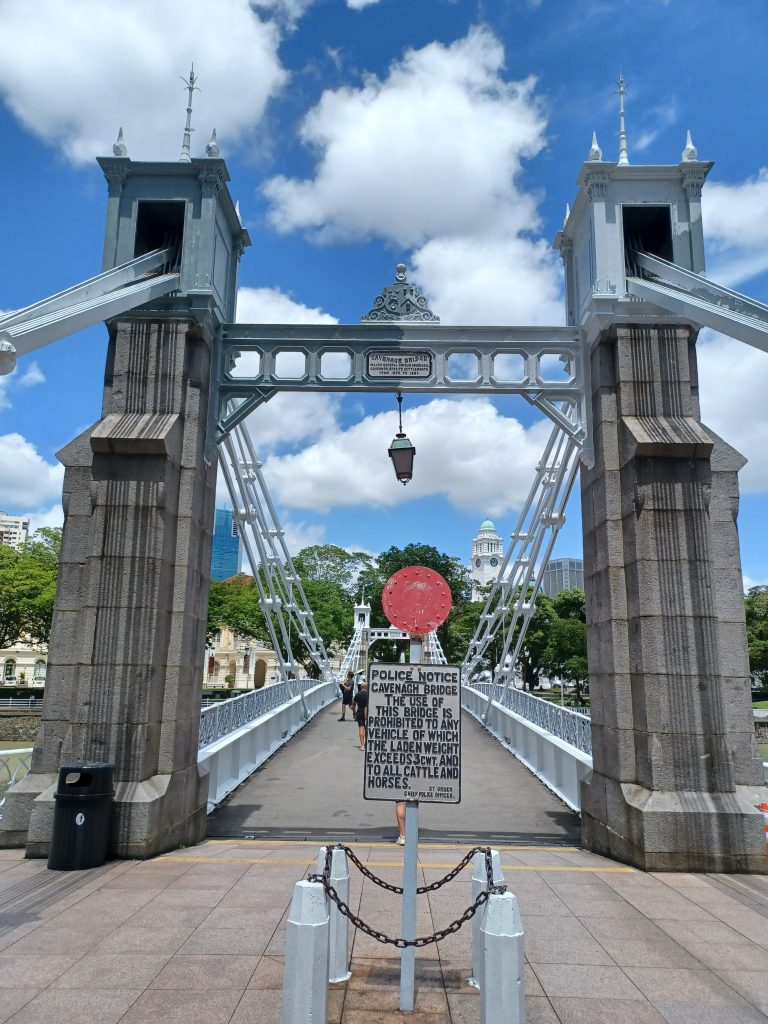
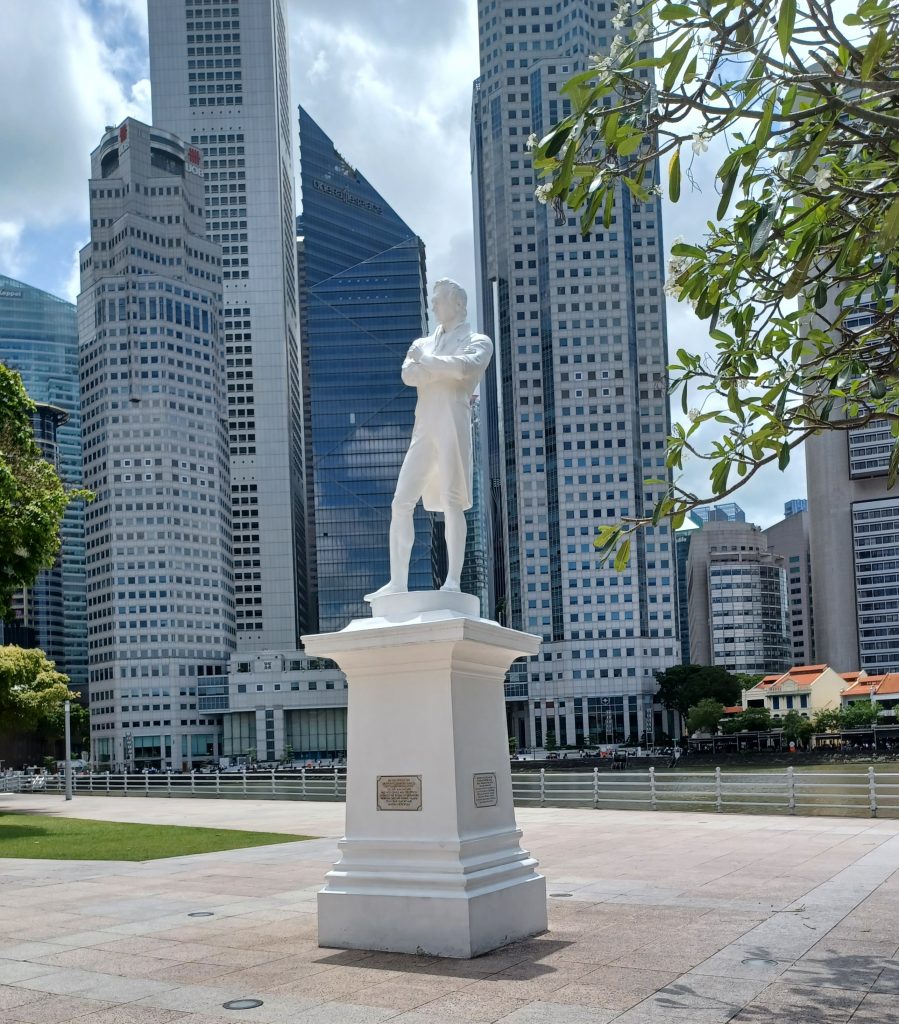
Marina Bay Sands Hotel
This afternoon I am off with my friend to Marina Bay Sands, that huge hotel dominating the skyline of Marina Bay. This building is incontrovertibly awe-inspiring. Tiny figures rack their necks to gawp at the rearing accommodation towers and the underside of the observation platform, where the infinity pool, only for hotel guests, and bar /restaurant straddle the top.
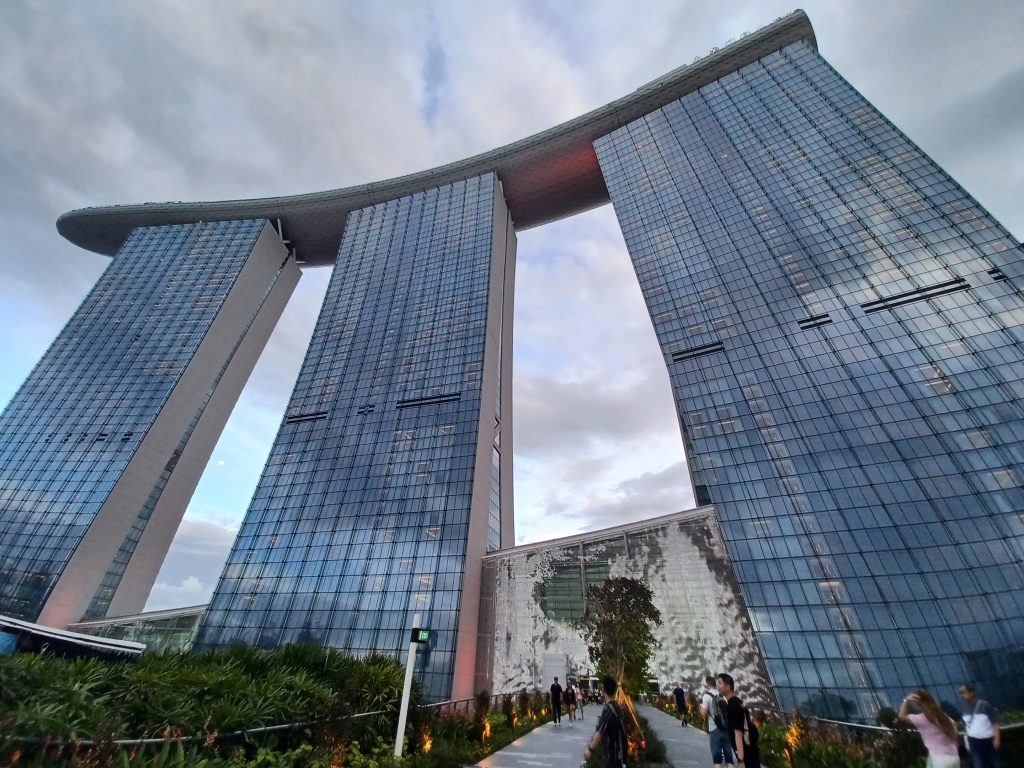
Purchase tickets for 75 Singapore dollars, redeemable for food and drink consumed, and ascend swiftly in the lift to the top. Find a plush seat by the glass railing with fantastic views over the city, including the container ships and oil tankers waiting to enter the harbour, and the super trees in Gardens by the Bay. See the Singapore Flyer and the Central Business District (CBD) with its dazzling skyscrapers with the old colonial Fullerton Hotel tucked in front. Look down upon the Apple and the Lotus. We order Singapore Slings. Notice they are cheaper than in the Raffles Hotel and the view is better. No monkey nuts though. Order appetisers too, which are quite sufficient as a main meal. Rather cloudy and breezy up here today it is, for which I am grateful. Makes for a very pleasant interlude.
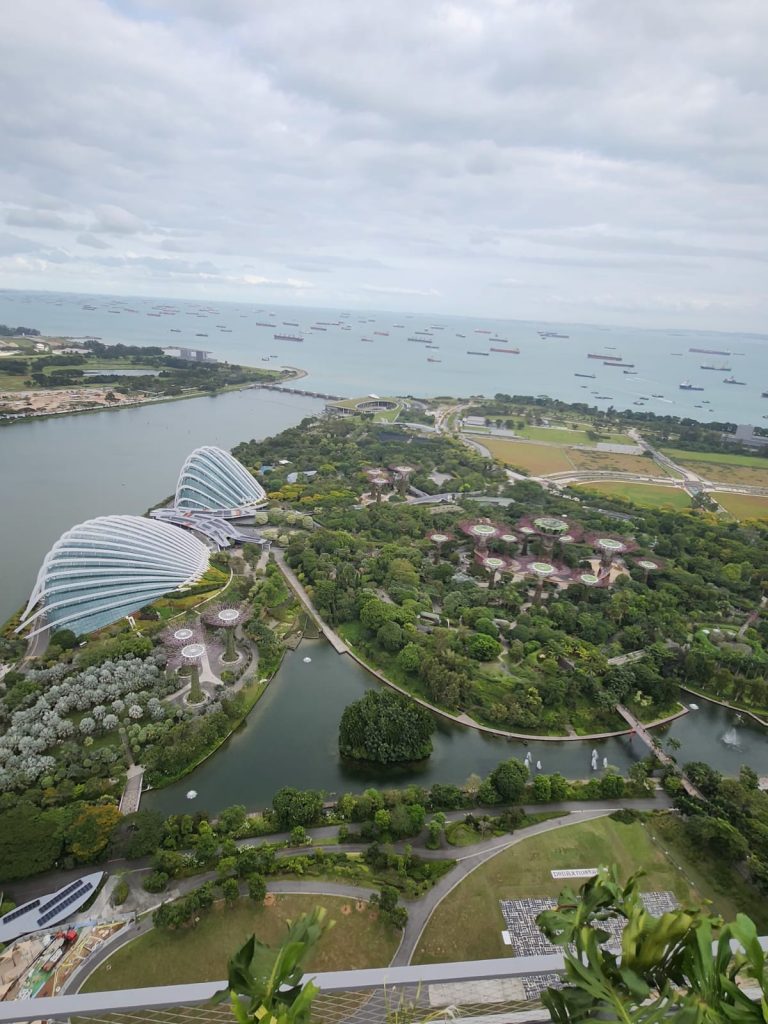
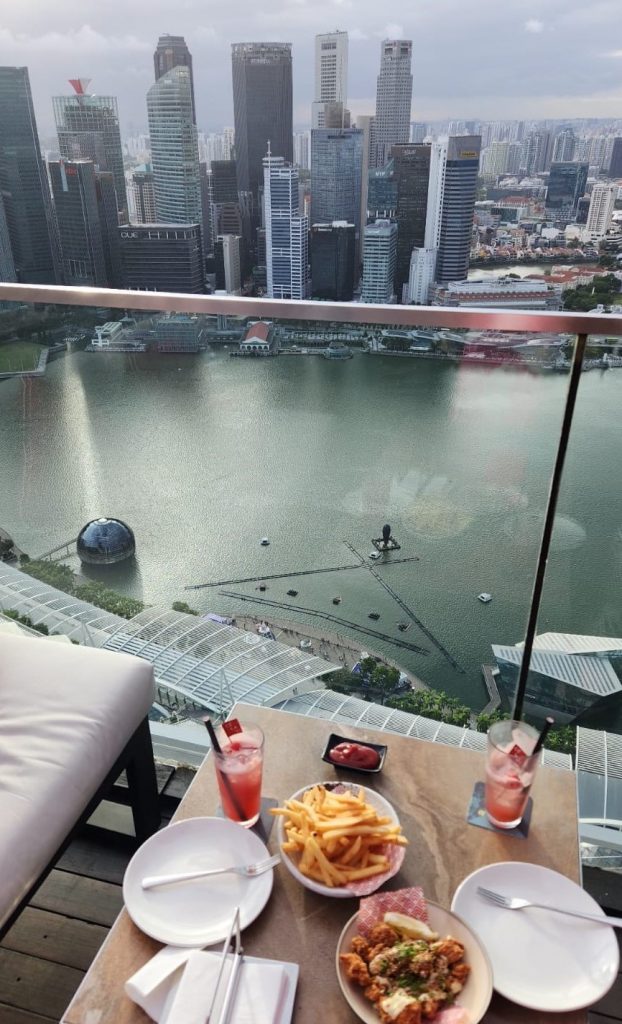
Gardens by the Bay
We leave this splendid spot and descend to the Gardens by the Bay for a light show. Dusk begins to fall and Marina Bay Sands Hotel switches on its lights. It doesn’t take long for the sun to set in the tropics. We head speedily for the super trees, crossing via a bridge over the water and noting the Singapore Flyer lighting up in the distance. People are perching all over the place, on benches if they can, on the ground if not. We squat upon the ground and wait for the announcement at 19:45 about the light show programme. This evening it will be accompanied by opera. Oh good. The trees come alive with flashing lights of yellows, reds, purples, greens and blues. The voice of Pavarotti booms arias from Verdi’s Il Trovatore and a diva sings extracts from Bizet’s Carmen. All rather sensational under a black cloudy sky. Think the heavens might open but they don’t. After the opera we are treated to ‘Borealis’, whereby steam is ejected from the super trees which, mixed with the lights, is supposed to resemble the Northern lights. Clever, but rather illogical in this climate: 30 degrees right now.
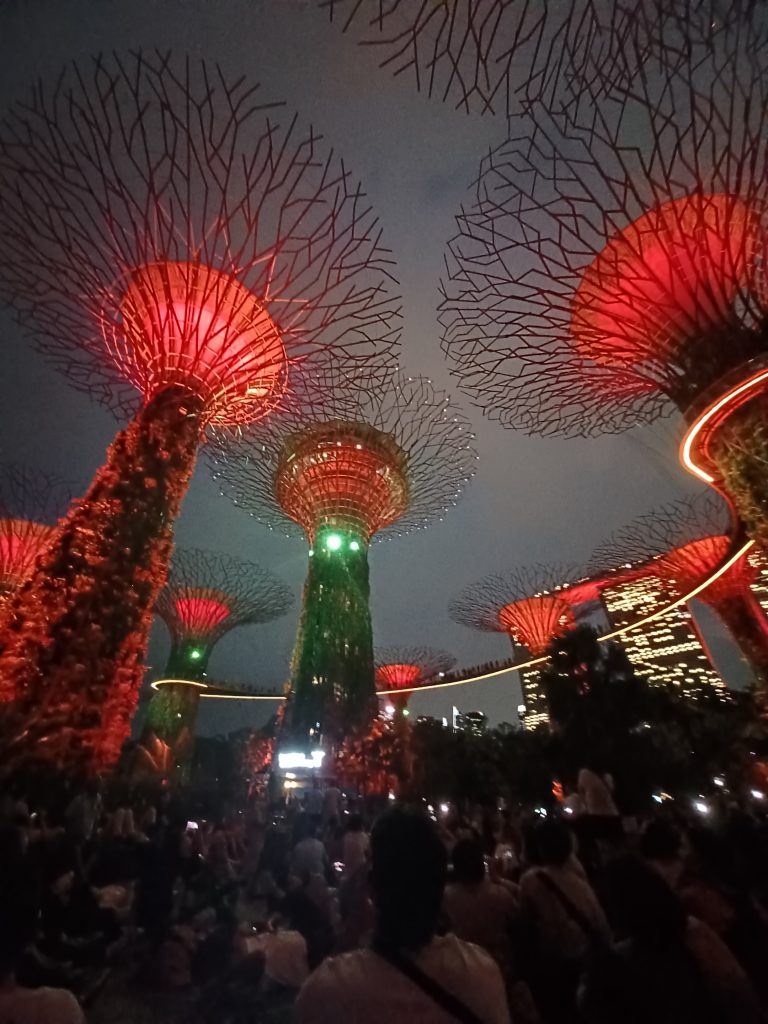
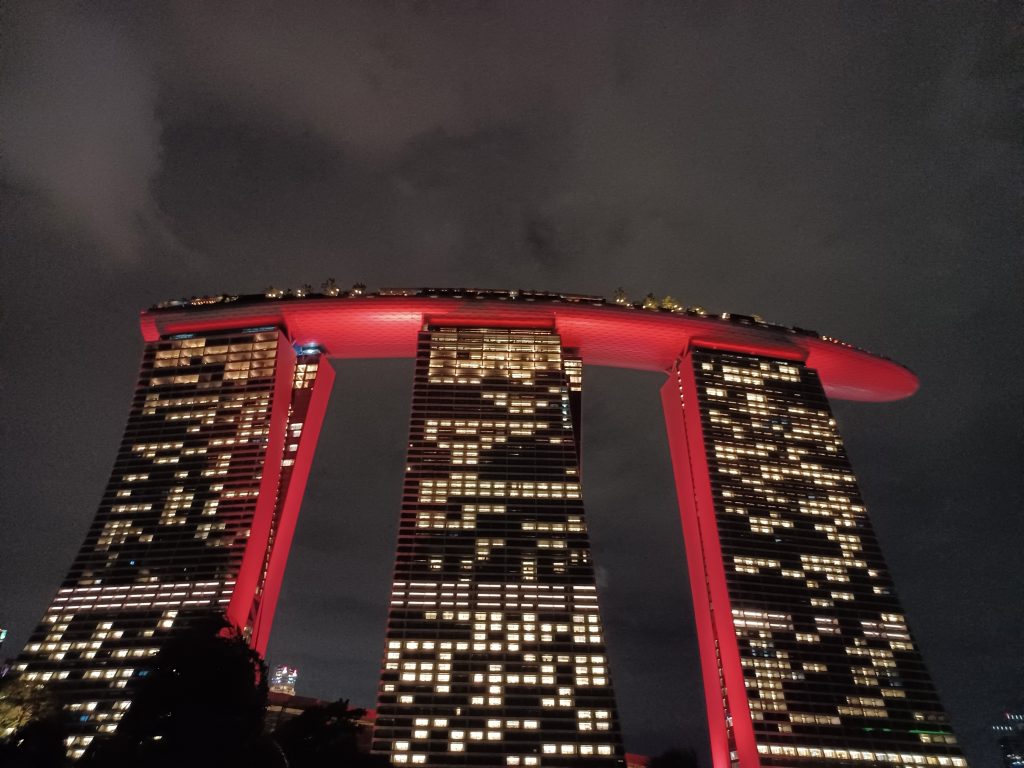
Sentosa Island
Last day in Singapore. Going to take the cable car to Sentosa Island or, as it used to be called, Pulau Blakang Mati. Used as a military base by the British and then a POW camp by the Japanese, it was renamed ‘Sentosa’ meaning ‘peace and tranquillity’ in the 1970s. It is now an amusement area with zip wires, luge and film studios. Great view from the cable car as we float across the Keppel Channel to the island. Thick forests, ships awaiting entry to the harbour (the Strait of Singapore is one of the world’s busiest commercial routes), palm strewn beaches and a four masted sailing ship. Large ferries also, connecting Singapore with Batam Island in Indonesia. Hmmm, that could be a fun voyage.
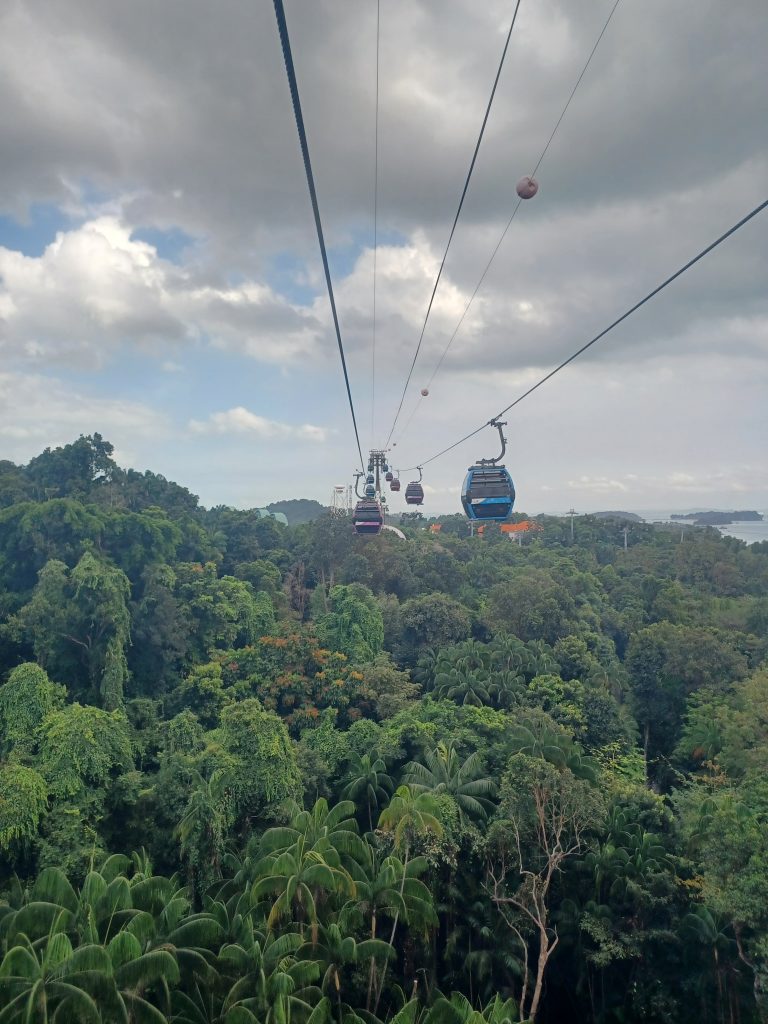
Fort Siloso
The island used to have four forts on it, built between the 1870s and 1890s, one of which, Fort Serapong, has become the Sentosa Golf Club course. Now only one fort remains. This is Fort Siloso, which was built to defend Singapore from the sea. Thus the guns were positioned to face seawards. Unfortunately for the defenders in 1942, the Japanese came overland from the north on bicycles, among other forms of transport, and overran Singapore. Although the guns were then rotated inwards, the Japanese, as we have seen, had taken the British by surprise and succeeded in their defeat of the British on 15th February, 1942. Somewhat humiliating for the empire. The British surrendered to General Yamashita after which followed a brutal occupation. The Chinese here suffered too. The Japanese had invaded China in 1937, especially Nanjing, and were excessively cruel. Some of the British and other POWs were force-marched to Changi prison on the east side of Singapore. Others sent to work on the infamous bridge over the river Kwai in Thailand (see Thailand, part 2: The Bridge over the River Kwai).
Anyway, the cable car brings us close to Fort Siloso and we dismount to explore. We enter the command posts, one of which has Feb 14th 1942 on the calendar, and models of the soldiers on duty. Realistic sound effects of gunfire and voices over the radio.
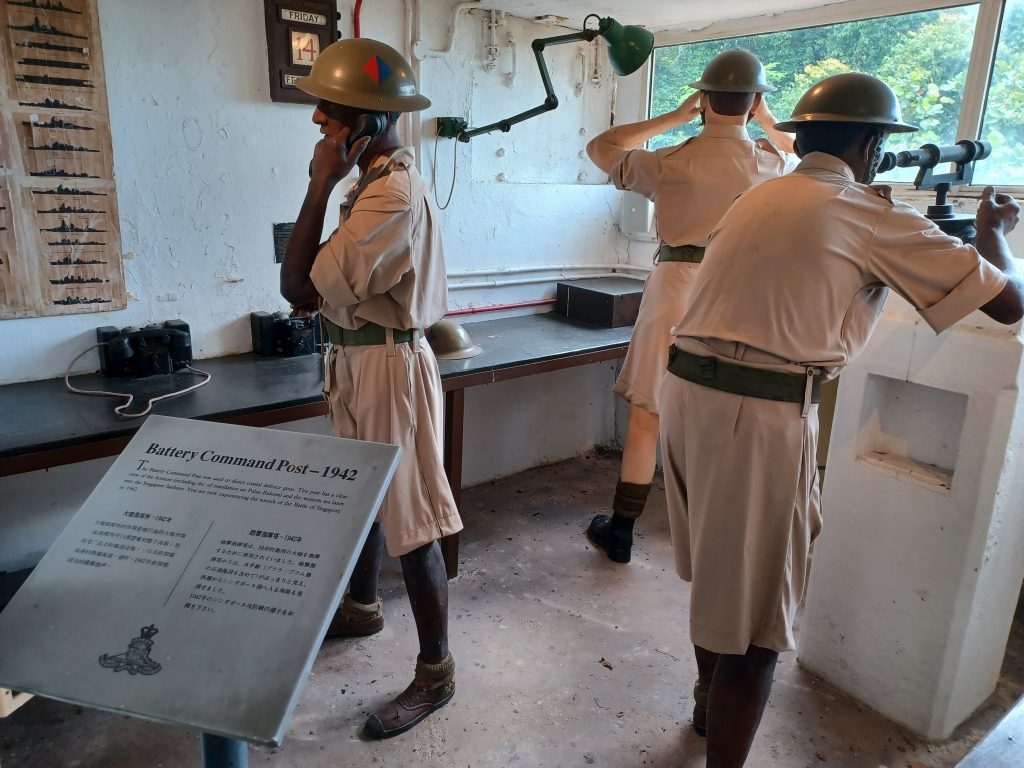
During the Battle of Singapore the Fort’s six inch guns did at least destroy a Japanese troop ship along with the British oil installations. This was in order to prevent these getting into Japanese hands. On the edge of the fort, adjacent to the Fire Director Tower a replica of a 12 pounder gun stares seawards. This gun was never fired and was tipped over the cliff for the same reason. A ferry can be spotted zipping past the firing point right now. Doubt we can be seen through all this foliage. Would have been clear 180 degrees vision or more, I should think, back then. A handy firing position here on the headland.
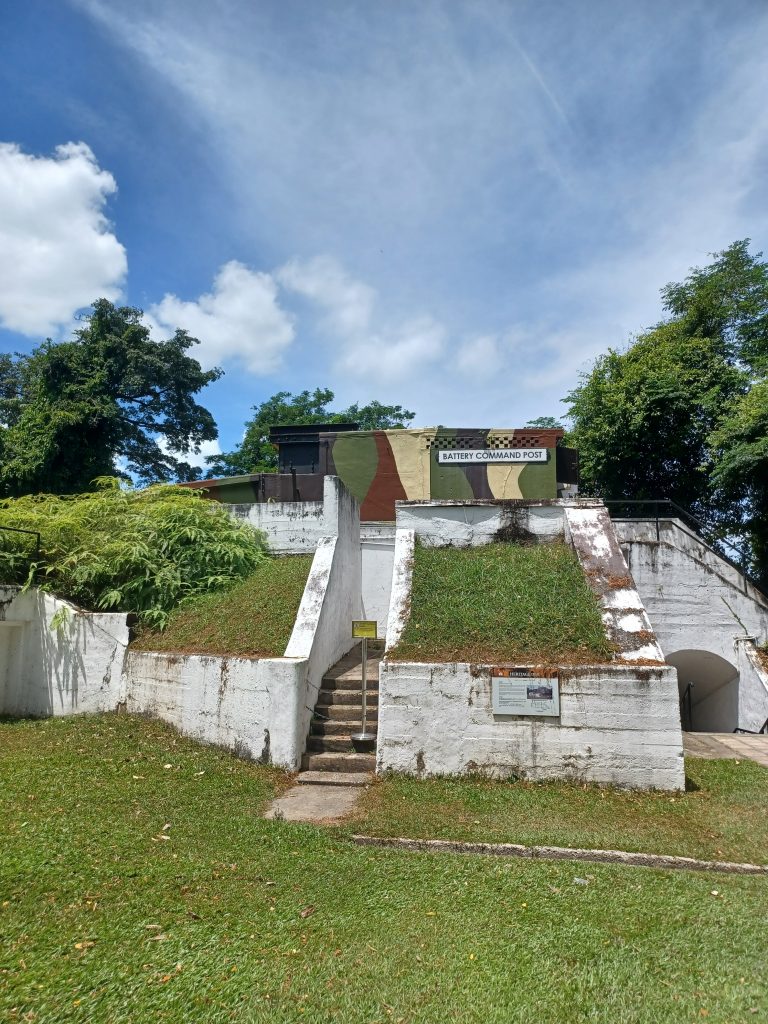
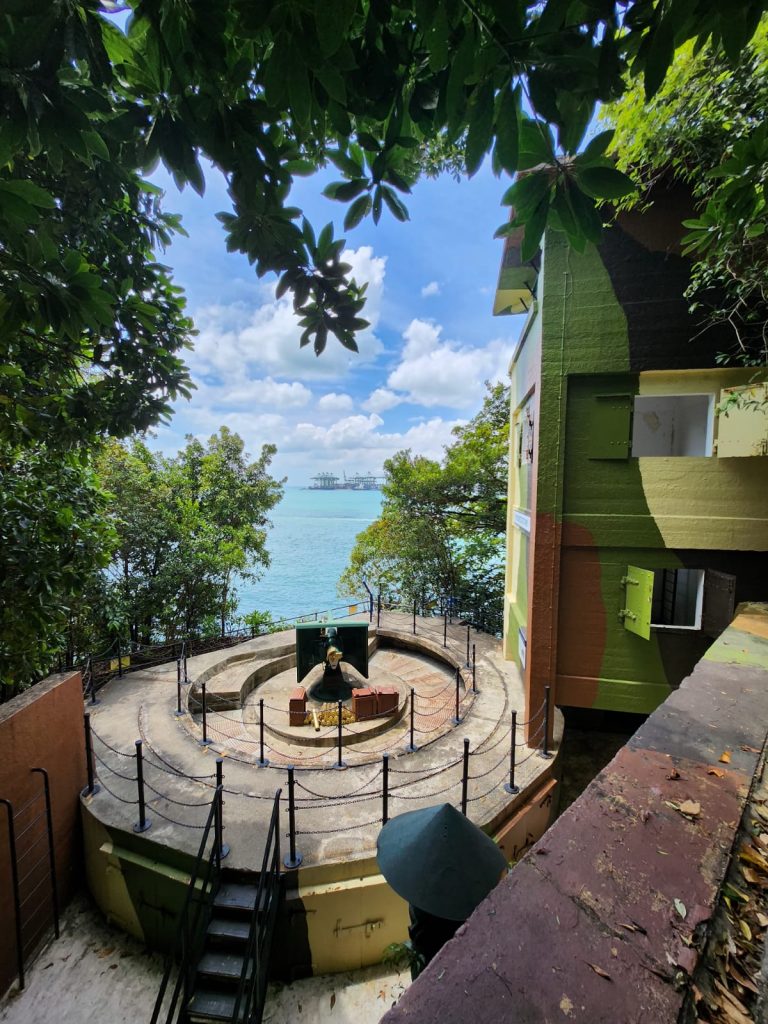
We explore tunnels and rooms with guns and shells and, in a surrender hut, we see models of those present at the later Japanese surrender to Admiral Lord Louis Mountbatten on 12th September, 1945. Also present were General Sir William Slim and Air Chief Marshall Sir Keith Park, among others. A rather happier occasion.
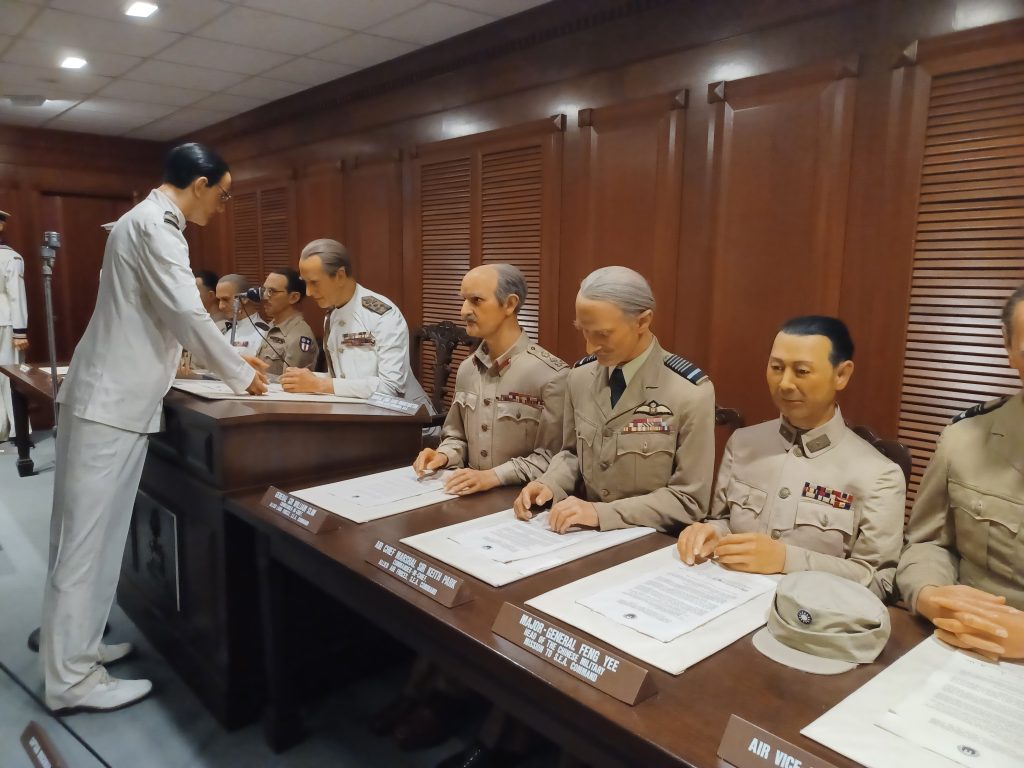
All exceedingly interesting but it is hot. We drift off back to a beach with soft white sand. A fenced off area of water prevents crocodiles and other nasties from spoiling the bathers’ enjoyment and the Shangri La restaurant provides cold drinks and nourishment. Then we take the cable car back to the mainland. Find a bar and say goodbye to my hospitable friend over Prosecco. Cheers. Tomorrow I am heading to Thailand.

Leave a Reply